- Portal de Turismo de Castilla y León

- Heritage and Culture
- Enotourism and Gastronomy
- Discover it
- My personal space
- Provincial capitals

Image gallery
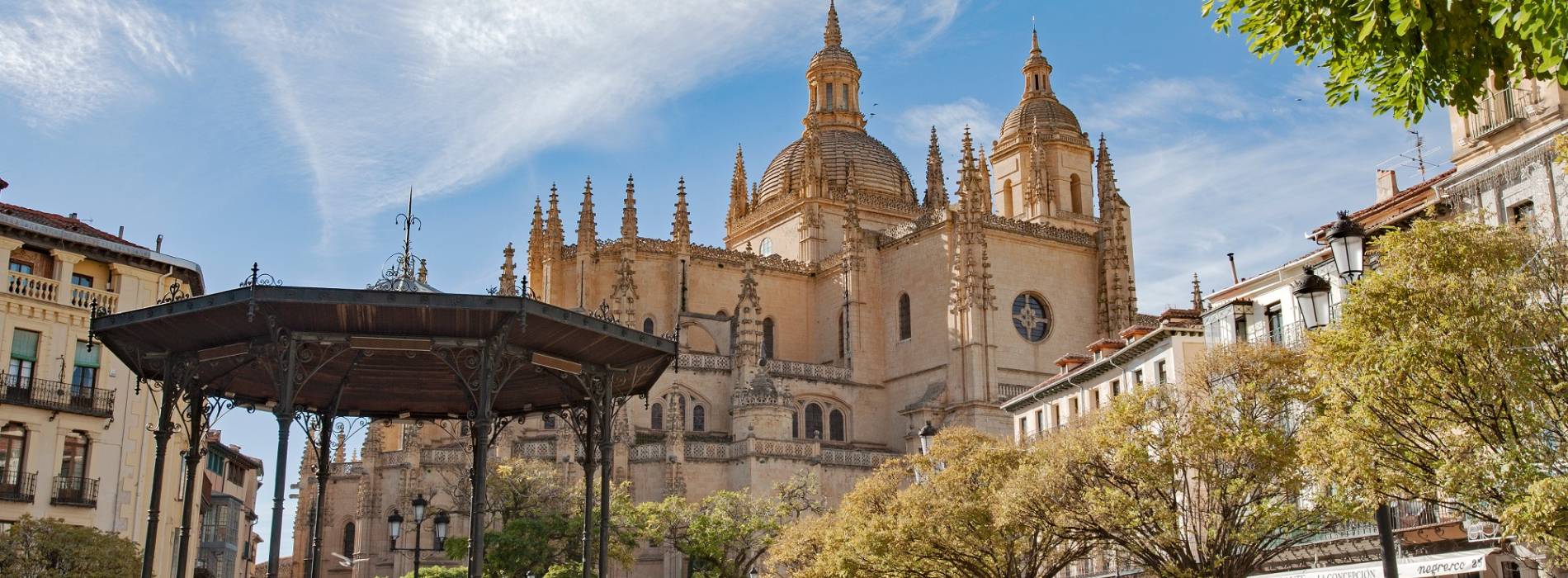
- Add/remove from notebooks
- PDF Version
In a privileged enclave with the Sierra de Guadarrama as a backdrop, south of the Community of Castile and León, stands the historic city of Segovia.
Discover the exceptional monuments that make Segovia a fairy tale city declared a World Heritage Site, in which both its wonderful aqueduct and its fantastic Alcázar stand out, but in whose streets and squares there are religious temples, palaces, convents and gardens.
The aroma that emanates from its wood-fired ovens, where suckling pigs and suckling pigs are cooked over low heat, permeates the streets and calls to the table.
We will wait for you!
Prepare your visit
- The construction of the Segovia Aqueduct
- Castile and León is Life Castile and León is...monumental! Segovia, World Heritage Site
- Segovia Aqueduct Castile and León awaits you!
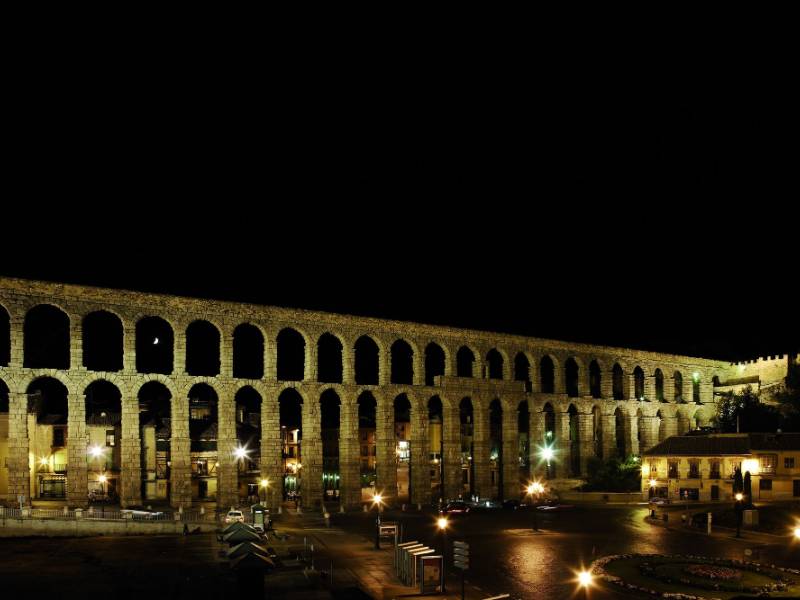
- is heritage
- is culture and traditions
- can be enjoyed and felt
- is gastronomy and enotourism
Get to know the surroundings
Address and map location.
It's happening

Tourist information
Segovia town hall.
- Postal address municipality of Segovia . Segovia
- Web www.turismodesegovia.com
- Phones 921 419 800
Segovia tourism office
Dependen de él los siguientes Puntos de Información Turística:
- Estación de Autobuses. Tlfno: 921 43 65...
- Postal address Plaza del Azoguejo, 1. Segovia. NaN. Segovia
- Email [email protected]
- http://www.turismodesegovia.com
- http://www.turismocastillayleon.com/
- 921 466 720
- 921 466 724
Centro de Recepción de Visitantes de Segovia
When to visit it.
Opening hours
- From Monday to Friday: 10:00 AM - 2:00 PM and 4:00 PM - 6:00 PM
- Saturdays: 10:00 AM - 6:00 PM
- Sundays: 10:00 AM - 3:00 PM
- Closed in the afternoon: Sundays
- From Monday to Friday: 9:30 AM - 2:00 PM and 4:00 PM - 7:00 PM
- Saturdays: 9:30 AM - 7:00 PM
- Sundays: 9:30 AM - 3:00 PM
- Every day: 10:00 AM - 7:00 PM
Observations: Closed on: December 25, January 01, 06 and the afternoons of December 24 and 31 and January 5.
This portal is not responsible for possible changes in the schedules and rates reflected
- Postal address Calle San Francisco, 32. Segovia. Segovia
- Email [email protected]
- Web http://www.segoviaturismo.es
- Phones 921 466 070
Publications
- Plan Guide of Segovia
Travel Safe
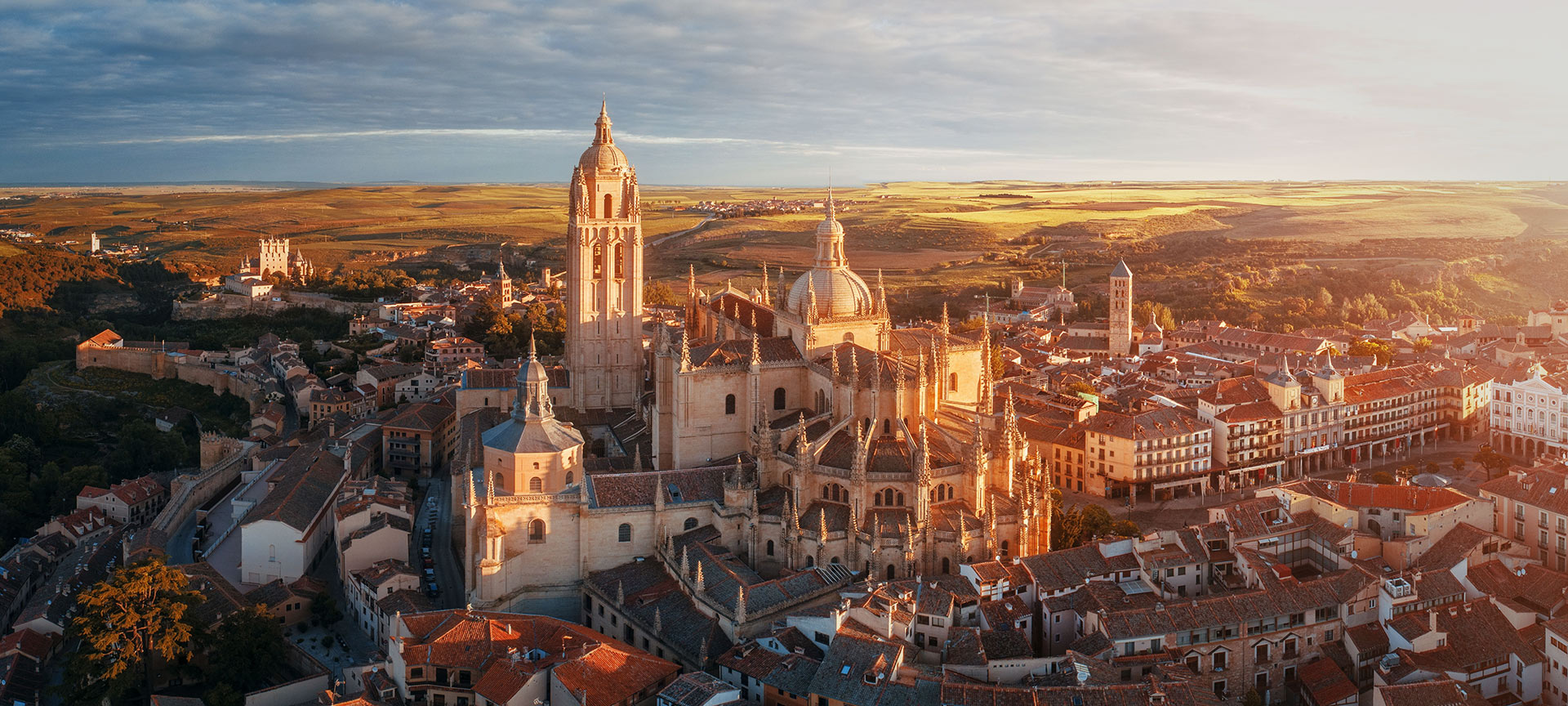
One-day tour of Segovia
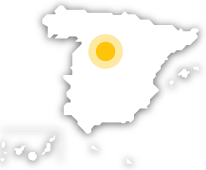
After you have seen its spectacular exterior, you can enter the Cathedral from Calle del Marqués de Arco, which leads onto Plaza Mayor. In the Visitor Centre on Plaza Azoguejo, you can hire guides to show you around the whole city and its heritage buildings. The best-conserved section of the Aqueduct is on Plaza Azoguejo, although other sections of the monument are still standing and in good condition. However, these parts have been reconstructed, as you can see from the style of the arches or from the stones themselves. The rest of the aqueduct extends to the mountains for about 14 kilometres. One of the best views of the Aqueduct can be had from the top of the Postigo steps beside it, next to the information centre. The remains of the former Jewish Cemetery are located in the green area known as El Pinarillo, opposite the Jewish Quarter.
This is the time to try the local cuisine. There are a host of restaurants in the streets leading off Plaza Mayor, in the area around the Cathedral and on Plaza del Azoguejo. If it’s a warm, sunny day, there are numerous terraces with impressive views of the monuments. To eat, there are famous local specialities, such as roast suckling pig or milk-fed lamb. If you prefer fish, trout is the best option.
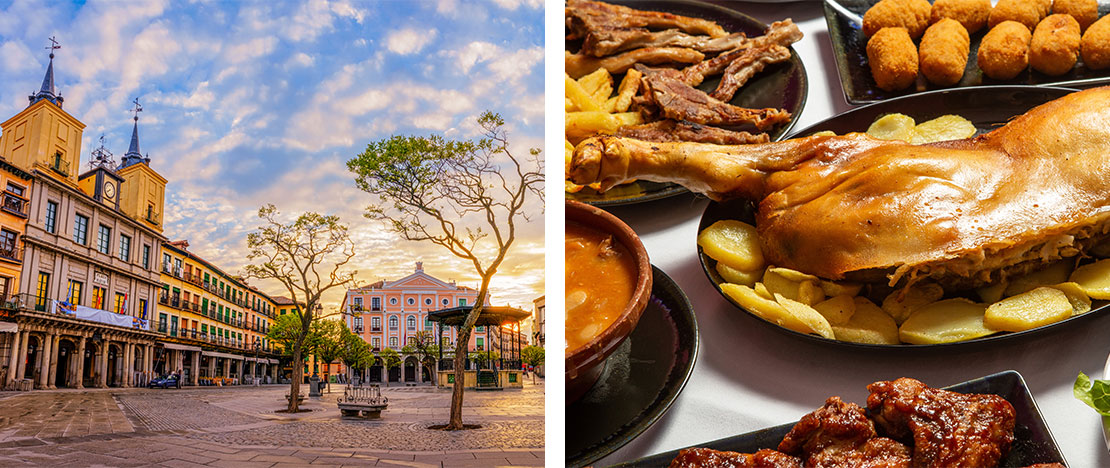
What to see
Places not to be missed
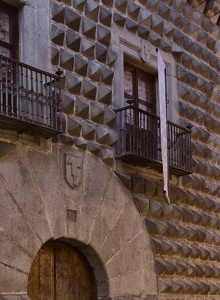
Casa de los Picos House

Church of San Martín (Segovia)
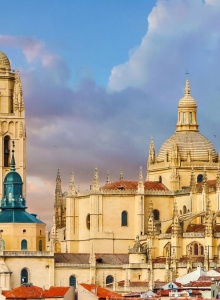
Segovia Cathedral
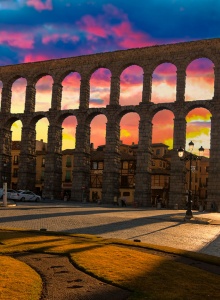
The Aqueduct of Segovia
When you take a trip to Segovia, a visit to the famous Alcázar fortress is a must. Then there's always enough time to go shopping before a very special dinner.
Visit to the alcázar and up to the tower.
Segovia is a city that can be explored on foot, and a gentle walk will take you to the Alcázar fortress. As well as visiting the interior, it is definitely worthwhile to climb to the top of the tower (152 stairs), as it offers outstanding views of the church of Vera Cruz and El Parral monastery. There is also another surprise in store for you: all around you, the mountains spread in waves like a great sea. Nearby, in the centre of the city, stands the Cathedral. The Aqueduct is a little lower down, although it cannot be seen from the Alcázar. Segovia’s layout and gradient mean that many people conceive of the city as a great ship, with the Alcázar at the prow, the Cathedral as the main mast, and the Aqueduct as the anchor cast into the sea, represented by the mountain range. Bearing this image in mind, your view from the top of the tower is like a sailor's in the crow's nest of a ship.
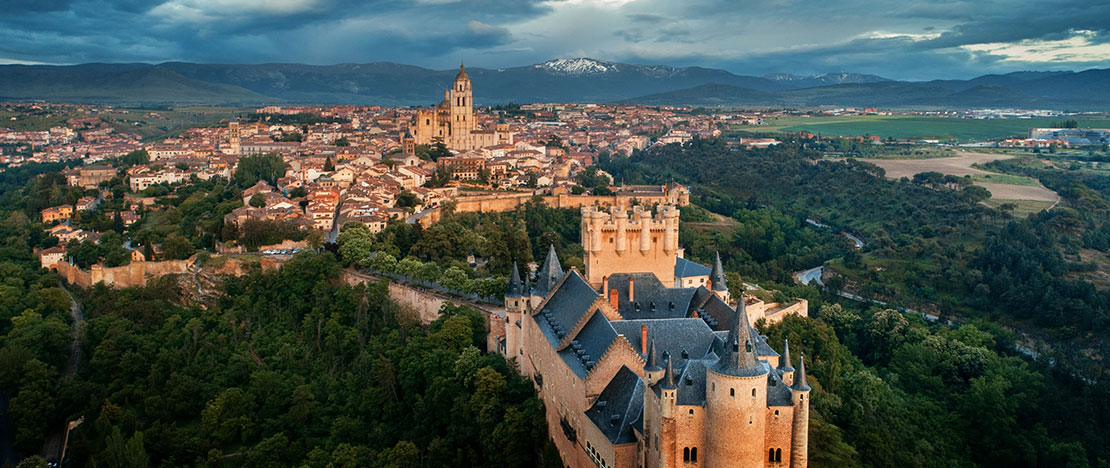
The visit to the Alcázar has two parts: the interior of the building, including the armoury and the chapel; and the tower. The climb to the tower, although not requiring any great levels of fitness, may be hard due to the shallow steps and the narrowness of the stairwell. It is advisable to book in advance for guided tours in languages other than Spanish.
Looking out over a balcony with a thousand views
Segovia is surrounded by a stretch of greenery that offers up a different view at every turn: a mysterious castle (the Alcázar) which rises from among the trees, a large river, and a fortified citadel with multiple towers. All this makes it an ideal spot for photographers. It's also a very brightly lit city, and particularly from May to September, is the perfect place for strolling amid the greenery against the backdrop of the Alcázar.
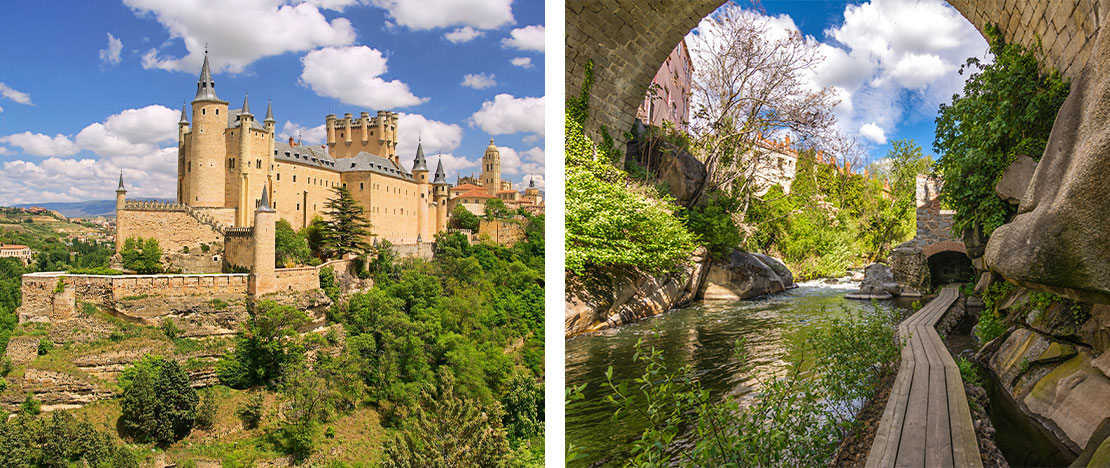
A good way to spend the afternoon, if you are not tired enough to go back to the hotel, is to head down from the Alcázar to the river Eresma and cross the bridge to visit the church of Vera Cruz, the Fuencisla shrine and the convent of the Carmelitas Descalzas or El Parral monastery. Also, if you take along something to eat, you can sit peacefully beside the river and have a picnic in the shade of the trees as you enjoy the afternoon. There are three signposted routes around the city, all of which take you through the Jewish cemetery, Fuencisla, Vera Cruz , El Parral and the convent of the Carmelitas Descalzas . These are highly recommended on a sunny day and will guarantee you take home some unique photos of Segovia.
Buying souvenirs
It’s time to go back to the walled city and pick up a few souvenirs. Go up via Puerta de Santiago, a road which is part of the Way of Saint James. The Poets’ Garden is a good place to stop and take some photographs. The area around Plaza Mayor is a great spot to find a whole range of souvenirs of the city, including typical local crafts, and all kinds of gifts.
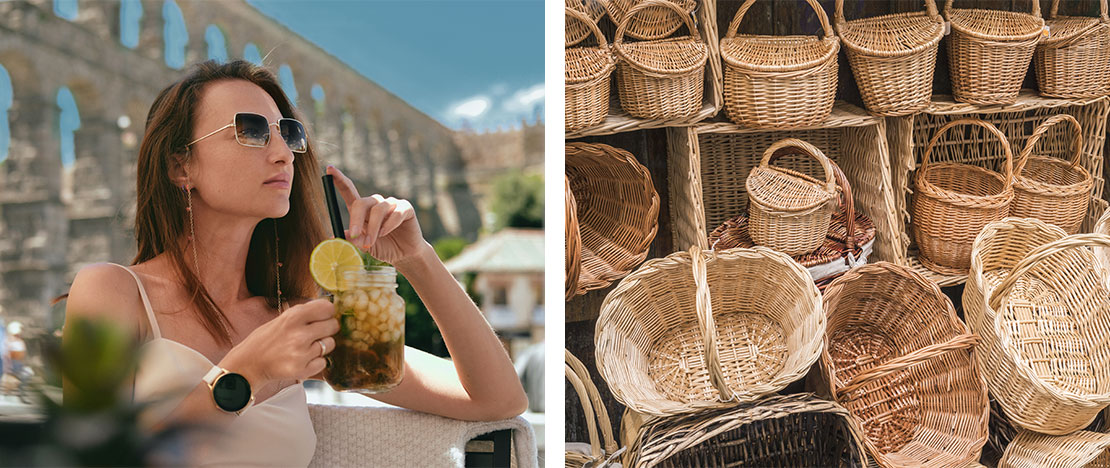
Dinner overlooking the illuminated Aqueduct
Paseo del Salón, Plaza Mayor, Plaza de Medina del Campo and the streets between them are full of places where you can whet your appetite with some typical Segovian tapas. But there's one unforgettable way of rounding off your day, and that is having a wonderful dinner against a backdrop of the illuminated Aqueduct. This is the perfect time to try some delicious wild mushrooms or tasty Cantimpalos chorizos. Afterwards, if you want to get a taste of Segovia’s nightlife, there are numerous venues in the San Millán area playing the latest music. If you feel like a leisurely stroll before returning to your hotel, the historic centre of the town, with all the monuments beautifully lit up, is an excellent option.
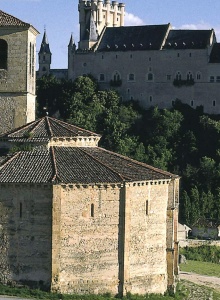
Church of La Vera Cruz
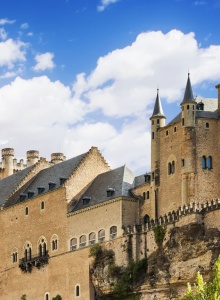
Alcázar fortress in Segovia

Monastery of San Juan de la Cruz. Discalced Carmelite Fathers
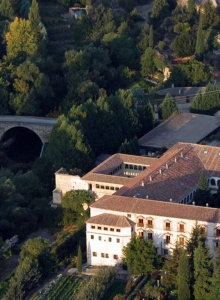
Monastery of Santa María del Parral
Tips and recommendations
Worth knowing
It is advisable to wear comfortable shoes, as Segovia is quite hilly. There is a small market in Plaza Mayor on Thursday mornings. You can rent bicycles on Plaza Mayor - a great way to enjoy the city’s green belt. El Parral has a mass in Gregorian chant every Sunday at midday. The Visitors' Centre arranges dramatised tours and night walks to learn about the city’s legends.
How to get there
Bus : there are various regular bus lines to and from Madrid, Avila and Salamanca, running numerous times a day. Train: several daily high-speed train services (AVE) connect with Madrid (approximately 30 minutes) and Valladolid (approximately 40 minutes). From the station, there is a bus service to the city centre (approximately 15 minutes) Road : Madrid – Segovia: on the A6 motorway, then continue on the AP6 and AP61. Approximate travel time: 1 hour 15 minutes. Avila – Segovia: on the A51 and continue on the AP6 and AP61. Approximate travel time: 1 hour. Plane : the nearest airports are Madrid (87 kilometres), Valladolid (125 kilometres) and Salamanca (164 kilometres).
Travel plans for inspiring you
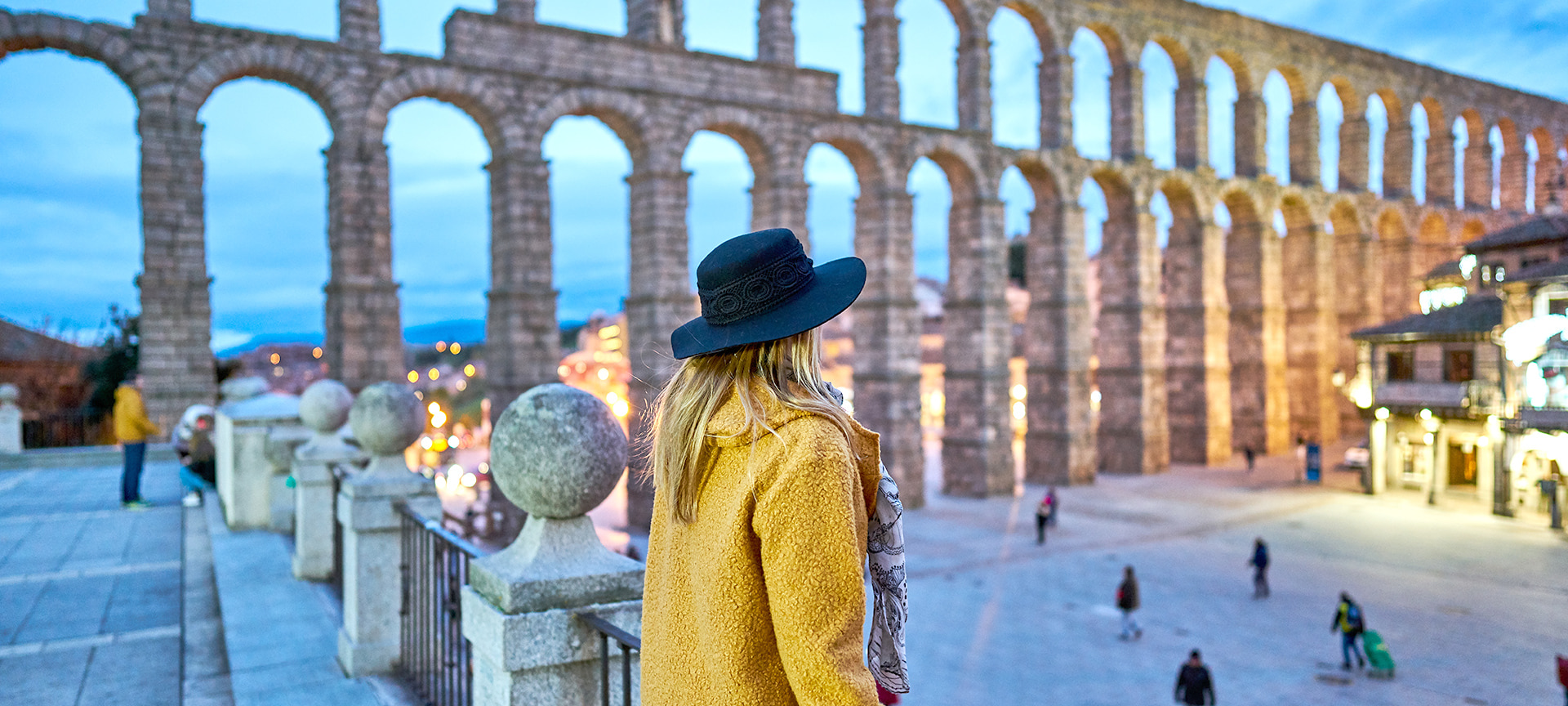
Segovia, a city with a long history, near Madrid
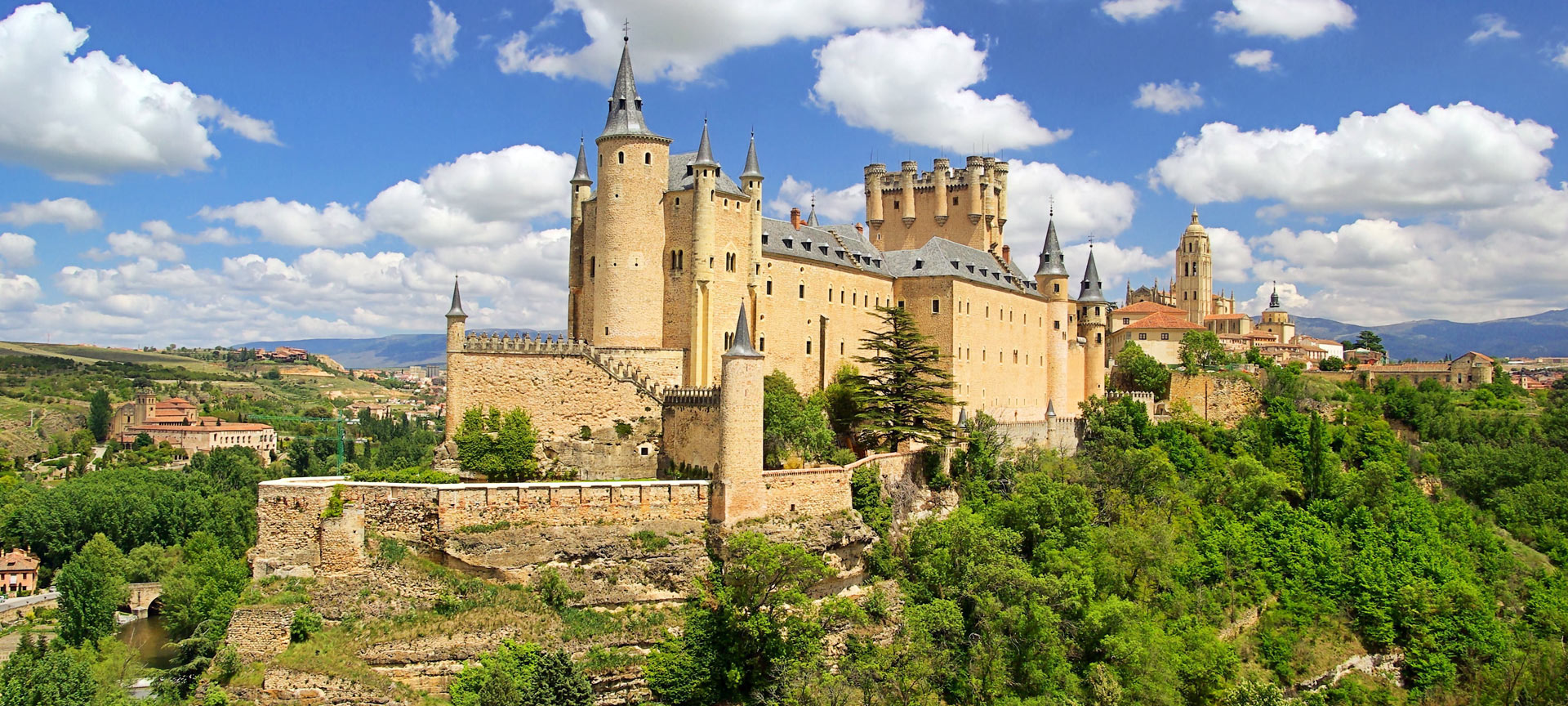
Castilla y Leon, a journey through time.
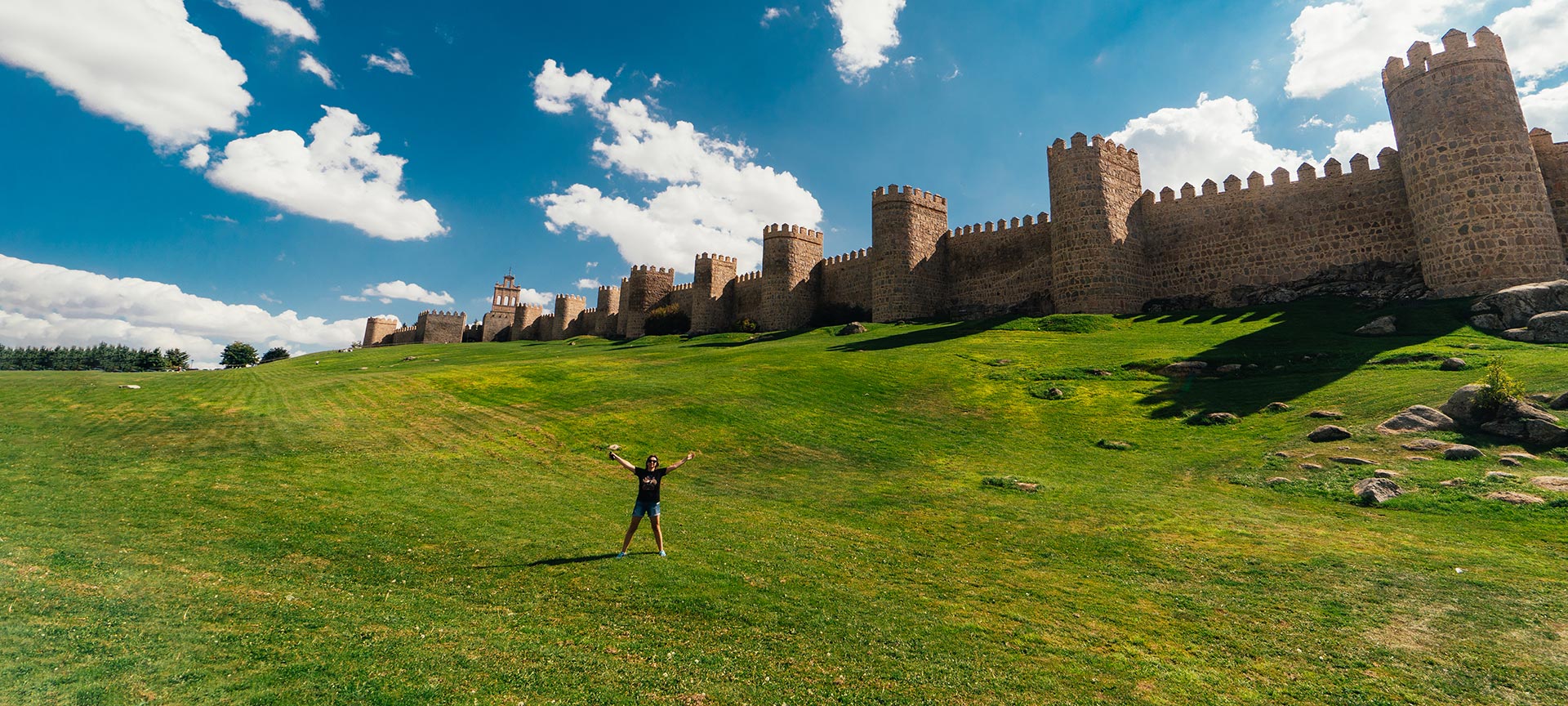
The foolproof guide to the cities of Castile and Leon

Choose between thousands of activities to live your best life on holiday.


What to see
Segovia has almost a hundred monuments, many of which can be visited, including museums, exhibition halls, monuments that will turn your visit to Segovia into an unforgettable memory. Check them all and plan your visit.

Museums (information in Spanish)

Exhibition Halls (information in Spanish)

Lookout points
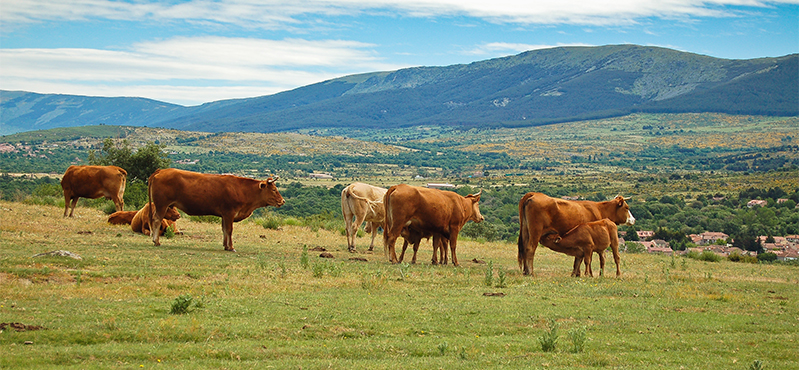
Barrios incorporados
Must-see attractions in Segovia

Segovia's most recognisable symbol is El Acueducto (Roman Aqueduct), an 894m-long engineering wonder that looks like an enormous comb plunged into Segovia…

Rapunzel towers, turrets topped with slate witches' hats and a deep moat at its base make the Alcázar a prototypical fairy-tale castle – so much so that…
Started in 1525 on the site of a former chapel, Segovia's cathedral is a powerful expression of Gothic architecture that took almost 200 years to complete…
Plaza Mayor
Watched over by the catedral, shady Plaza Mayor is the nerve centre of old Segovia, lined by an eclectic assortment of buildings, arcades and cafes and…
Plaza de San Martín
This is one of the most captivating small plazas in Segovia. The square is presided over by a statue of Juan Bravo; the 14th-century Torreón de Lozoya, a…
Iglesia de Vera Cruz
This 12-sided church is one of the best preserved of its kind in Europe. Built in the early 13th century by the Knights Templar and based on Jerusalem's…
Museo Gastronómico
This engaging little private museum takes you through the wonderful world of Spanish foods, with a focus on those from the Segovia region. There are…
Centro Didáctico de la Judería
This interpretation centre and museum in Segovia's old Jewish quarter provides a fascinating history of the Jewish community in Segovia. It occupies the…
Iglesia de San Martín
The centrepiece of the stunning Plaza de San Martín, this is a Romanesque pièce de résistance, with the segoviano touch of a Mudéjar tower and arched…
Convento de San Antonio El Real
About 1.3km southeast of the aqueduct, this was once the summer residence of Enrique IV. The Gothic-Mudéjar church has a splendid ceiling. It's still a…
Monasterio de Santa María del Parral
Ring the bell to see part of the cloister and church; the latter is a proud, flamboyant Gothic structure. The monks chant a Gregorian Mass at noon on…
Iglesia de San Esteban
Not far down the hill northwest of the Plaza Mayor, this beautiful church has a lovely, six-level sandstone tower and a baroque interior.
Museo de Arte Contemporáneo Esteban Vicente
This adventurous art space occupies a 15th-century palace (complete with Renaissance chapel and Mudéjar ceiling). Some 153 abstract paintings, lithographs…
Iglesia de San Miguel
On Plaza Mayor, this church – where Isabel was proclaimed Queen of Castile – recedes humbly into the background before the splendour of the cathedral…
Convento de los Carmelitas Descalzos
This is where San Juan de la Cruz is buried. The convent is still occupied by an order of nuns known as the Barefoot Carmelites. The area immediately…
Casa-Museo de Antonio Machado
This museum commemorates Antonio Machado, a segoviano and one of Spain's pre-eminent 20th-century poets, who lived here from 1919 to 1932. His former home…
Casa de los Picos
A grand Renaissance mansion with a diamond-patterned facade that's home to a school of applied arts and also hosts free contemporary art exhibitions …
Torreón de Lozoya
This 14th-century tower was once an armoury; it now houses temporary exhibitions of mostly contemporary art.
Iglesia de San Millán
Located off Avenida de Fernández Ladreda, this church is a time-worn example of the Romanesque style typical of Segovia, with porticoes and a Mudéjar bell…
Iglesia de San Clemente
A late-Romanesque church, the Iglesia de San Clemente is close to the Plaza del Acueducto.
* art, culture & responsible travel in Spain *

The best 10 things to do (and visit) during one day in Segovia (Spain)
Segovia is a delightful and historic city in central Spain. Famous for its spectacular Roman aqueduct, medieval castle, and well-preserved old town, it has been a popular tourist destination for centuries. With its rich history, stunning architecture, and breathtaking views, it’s a wonderful cultural destination.
This article aims to provide a comprehensive guide to Segovia. Here, we will highlight 10 of the best things to do during one day in this beautiful city. Whether you’re a first-time visitor or a seasoned traveler, this guide will help you make the most of your time in Segovia and experience its unique beauty and rich culture.
So, pack your bags and get ready to explore one of Spain’s most captivating cities!
“Cities, like dreams, are made of desires and fears, even if the thread of their discourse is secret, their rules are absurd, their perspectives deceitful, and everything conceals something else.” Italo Calvino
Top 10 Things to Do in Segovia (in One Day)
The best time to visit Segovia is during the spring and autumn. Then, the weather is mild, and the crowds are smaller. Nevertheless, regardless of when you visit, Segovia is sure to be a memorable experience, with its rich history, stunning architecture, and breathtaking views.
1. Visit the Roman Aqueduct
The Roman aqueduct is one of Segovia’s most famous landmarks and a must-visit for anyone exploring the city. This stunning piece of ancient engineering is a testament to the city’s Roman heritage. It’s worth mentioning that it is one of the best-preserved aqueducts in the world.
Constructed over 2,000 years ago, the Roman Aqueduct stands tall as a symbol of Segovia’s rich history. Visitors can admire the aqueduct’s impressive size and intricate design as they stroll through the city center. With over 170 arches spanning nearly 900 meters, the aqueduct is an awe-inspiring sight into the past.
Whether you’re a history buff or simply looking to experience something unique, visiting the Roman Aqueduct is a must-do while in Segovia. It’s a great way to start your day and get a feel for the city’s rich cultural heritage.
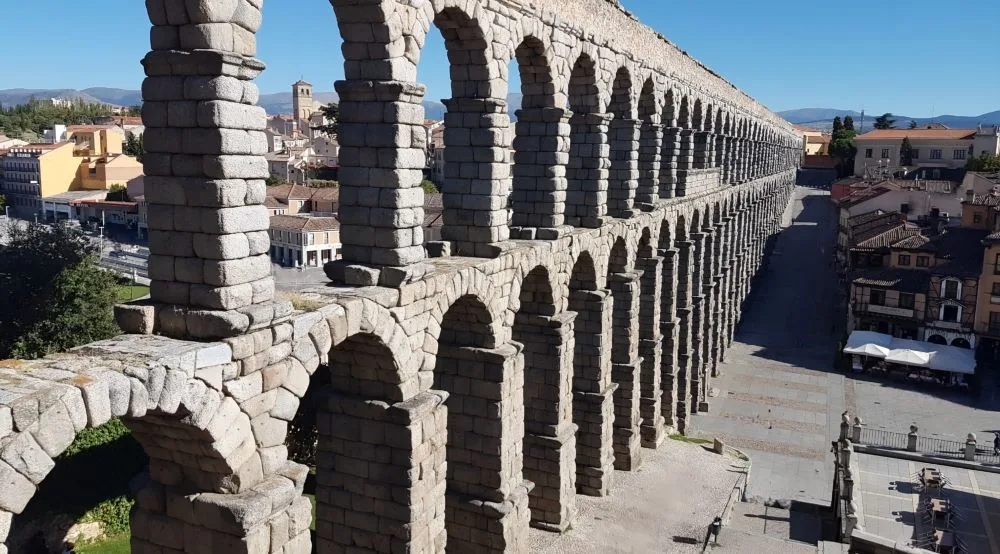
2. Explore the Alcázar (Castle) of Segovia
The Alcázar of Segovia is one of the city’s most iconic landmarks, and it’s easy to see why. The castle’s unique mix of Gothic and Mudéjar architectural styles creates a stunning visual contrast that will leave visitors in awe. Moreover, its location on a rocky crag overlooking the city also provides breathtaking views of Segovia and the surrounding countryside.
Visitors can take a guided tour of the Alcázar of Segovia to learn about its history and significance. The castle has served as a royal palace, a prison, and a military academy over the centuries. Visitors will learn about these different uses and the important events that took place there. The castle’s well-preserved interiors, including the royal apartments and the chapel, also provide a glimpse into the lives of Segovia’s past rulers.
Climbing to the top of the tower is a must-do while exploring the Alcázar of Segovia . The views from the top are simply breathtaking and provide a unique perspective of the city. Visitors can see the entire city, the surrounding countryside, and the stunning panoramic views of Segovia’s historic landmarks.
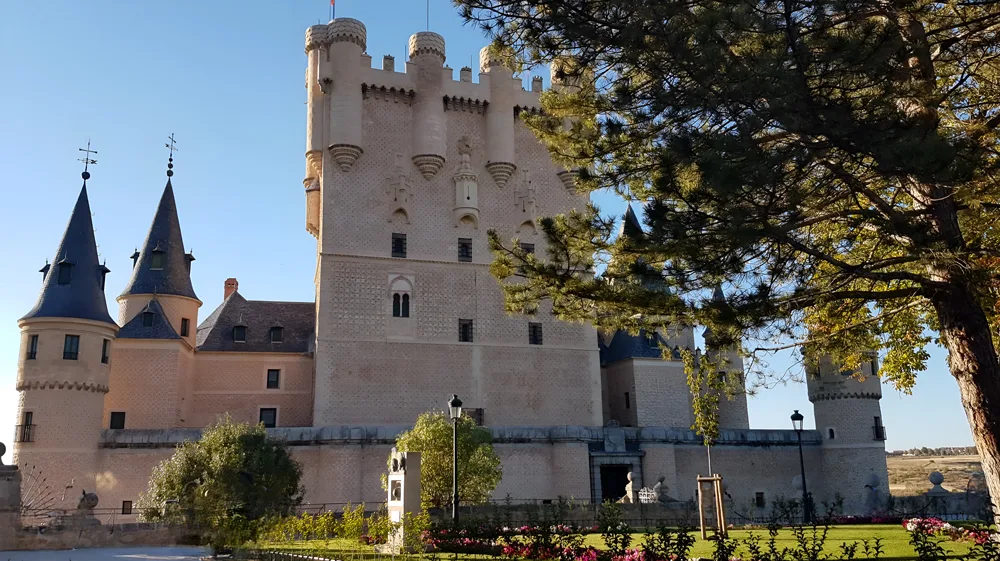
3. Walk Through the Old Town during your one-day trip to Segovia
Segovia’s old town is filled with historic buildings and narrow, winding streets, making it the perfect place to explore on foot. Take your time wandering the streets, admiring the architecture, and stopping at local shops and restaurants.
Walking through Segovia’s old town is a must-do for anyone visiting the city. The old town is filled with historic buildings and narrow, winding streets, making it the perfect place to experience the city’s rich history and culture. The architecture in the old town ranges from Gothic to Renaissance, and visitors will find themselves surrounded by stunning buildings and charming plazas.
As you wander through the streets, be sure to stop at local shops and restaurants. Segovia is famous for its traditional cuisine; you’ll find plenty of opportunities to sample local dishes and drinks. The local shops offer a wide range of souvenirs, handcrafted goods, and traditional Spanish items.
Visitors can also take a guided tour of the old town, which provides an in-depth look at Segovia’s history, culture, and architecture. You’ll learn about the city’s rich past, including the different cultural and architectural influences that have shaped Segovia over the centuries. The tour provides a unique perspective on the city and its landmarks, and it’s a great way to get a feel for the local culture and way of life.
Walking through Segovia’s old town is a great way to spend a day in the city. Whether you’re a history buff, an architecture enthusiast, or simply looking for a unique experience, the old town is a must-visit while in Segovia.

4. Visit the Cathedral of Segovia
The Cathedral of Segovia is a stunning example of Gothic architecture and constitutes one of Spain’s finest cathedrals. The cathedral is located in the heart of the old town and is open daily to visitors.
It was built in the 16th century and is considered one of Spain’s finest examples of Gothic architecture. The cathedral’s exterior features intricate carvings, statues, and gargoyles, making it an actual work of art.
Inside, visitors will find a grand interior, characterized by soaring arches, stained-glass windows, and elaborate stone carvings. The cathedral is home to several important works of art, including paintings and sculptures and intricate stained-glass windows dating back to the 16th century.
Visitors can take a guided tour of the cathedral, which provides a detailed look at its history, architecture, and art. The tour offers an in-depth understanding of the cathedral’s role in Spanish history and culture and provides a unique perspective on the city of Segovia.

5. Try Segovia Cuisine
Segovia is famed for its local cuisine, which includes dishes such as ”cochinillo asado”. In addition to traditional meat dishes, Segovia also offers a variety of vegetarian-friendly options. From local taverns to upscale restaurants, there are plenty of places to enjoy a delicious, meat-free meal in Segovia.
Popular vegetarian options in Segovia include hearty stews made with seasonal vegetables, fresh salads, and tasty tapas dishes. You can also try traditional Spanish dishes like tortilla española, an omelet made with potatoes and onions.
For those with a sweet tooth, there are plenty of delicious dessert options, such as the famous “yemas” de Segovia, which are small, sweet treats made with sugar and egg yolks.
In addition to its food, Segovia is also known for its local wines, produced in the surrounding countryside. Whether you prefer red, white, or rosé, there are plenty of delicious local options to choose from.
Overall, Segovia’s cuisine is a big part of what makes the city such a popular destination for travelers. Whether you’re a meat lover or a vegetarian, be sure to try some local specialties during your time in Segovia.
6. Visit the Church of San Esteban
The Church of San Esteban is a beautiful Gothic church located in the heart of the old town. The church is renowned for its intricate stained-glass windows and is a beautiful case of medieval architecture.
The church was built in the 14th century and has undergone several renovations over the years, including the addition of a stunning Renaissance-style facade in the 16th century.
Inside, it features stunning works of art, including carved altarpieces, intricate stained-glass windows, and frescoes that adorn the walls and ceilings. Visitors can also admire the church’s beautiful gilded ornamental screen that separates the altar from the rest of the church.
The Church of San Esteban is also notable for its beautiful cloister, a peaceful, tree-lined courtyard surrounded by columns and arches. The cloister is a popular spot for visitors to relax and soak up the tranquil atmosphere of the temple.

7. Discover the Monastery of San Antonio el Real
The Monastery of San Antonio el Real is a stunning medieval monastery located just outside Segovia. The monastery was founded in the 14th century and constitutes one of Spain’s finest examples of Gothic architecture.
Visitors to the Monastery of San Antonio el Real can admire its beautiful cloister, surrounded by delicate arches and columns. The cloister is a peaceful oasis in the heart of the monastery, and a place to relax and soak up the serene atmosphere.
Inside the monastery, visitors can admire a beautiful collection of frescoes and paintings, which adorn the walls and ceilings. The monastery’s church is also a must-visit, with its intricate Gothic architecture and beautiful stained-glass windows.
In addition to its stunning architecture, the Monastery of San Antonio el Real is also notable for its history. It was a center of learning and spirituality for centuries. Therefore, it played a significant role in developing Segovia’s culture and history.
Visitors to the Monastery of San Antonio el Real can explore the building’s history and learn about its role in Segovia’s past, while admiring its stunning architecture and peaceful atmosphere.
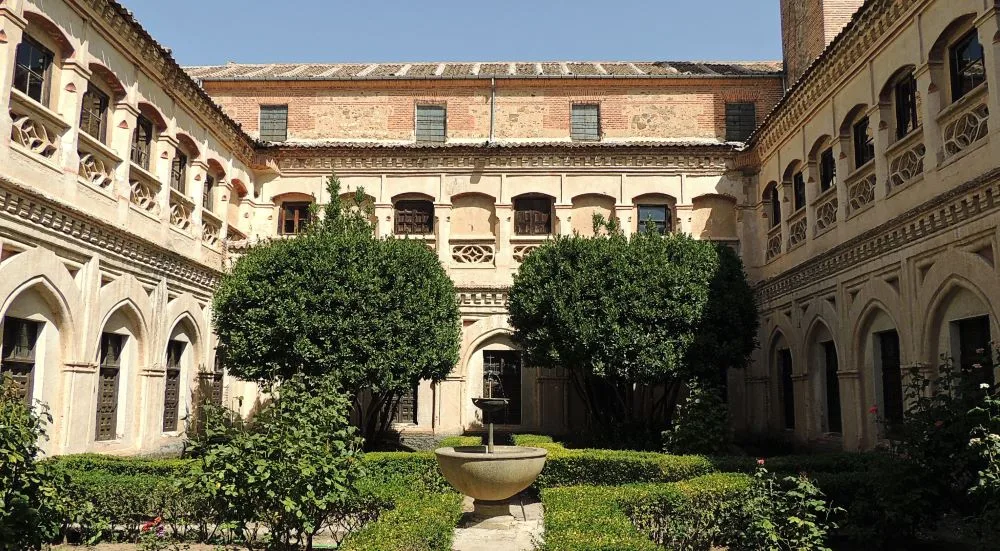
8. Visit the Segovia Museum
The Segovia Museum is a fascinating museum located in the heart of the old town. The museum showcases the history and culture of Segovia. It includes exhibits on the city’s Roman heritage, medieval history, and local culture.
Here, you will have the opportunity to see artifacts and exhibits from throughout the city’s history, including Roman mosaics, medieval armor, and religious art. The museum is a great place to learn more about Segovia’s rich cultural heritage. It provides a more profound understanding of the city’s history and cultural significance.

9. Explore the Palace of the Dukes of Béjar
The Palace of the Dukes of Béjar is a stunning palace located in Segovia’s old town. Built in the 16th century, the castle was once the residence of the Dukes of Béjar and is now open to visits. Moreover, the palace features beautiful Renaissance architecture, including a stunning courtyard and an elaborate facade.
Visitors can explore the palace’s grand halls, admire its intricate carvings, and learn about the history of the Dukes of Béjar.
Furthermore, this building also houses a museum showcasing the history of Segovia and its cultural heritage. So, if you’re seeking a unique place to explore in Segovia, the Palace of the Dukes of Béjar is definitely worth a visit.
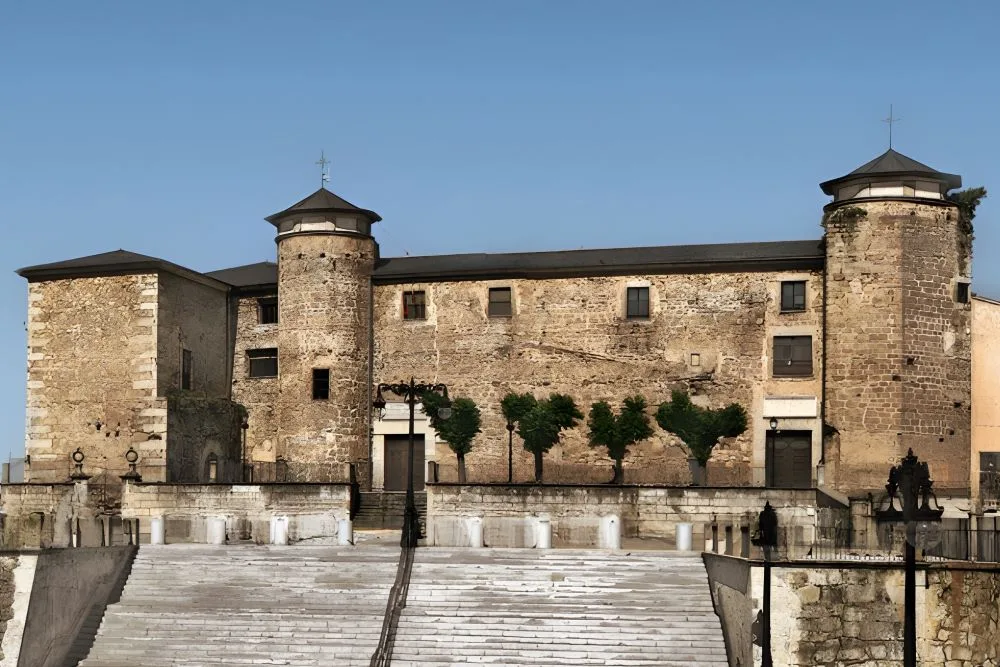
10. Discover the legends of the Church of Vera Cruz
If you’re lucky enough to spend a day in the historic city of Segovia, make sure to add the Church of Vera Cruz to your itinerary. This stunning temple, nestled just outside the city walls, has a rich and intriguing history for visitors of all ages.
Originally built in 1208 as the parish church of Zamarramala, the Romanesque temple has generated legends and myths for centuries. Some claim that the Knights of the Order of the Temple chose this location due to a mysterious, untold force. Others argue it was founded by the Order of the Holy Sepulcher.
Regardless of its origins, the Church of Vera Cruz has been a place of pilgrimage for centuries. Attracting visitors from all over the world who come to see the reliquary containing a piece of the Lignum Crucis , the Cross where Jesus Christ died.
Whether you’re a history and architecture enthusiast or just looking for a unique cultural experience, the Church of Vera Cruz is a must-see landmark. Because it is much more than just a religious building — it’s a window into Segovia’s fascinating and mysterious history.


Concluding the one-day visit of Segovia
Segovia has a rich history and stunning architecture, making it a must-visit destination for anyone exploring Spain. From the Roman Aqueduct to the Alcázar of Segovia, there is no shortage of incredible sights to see and experience in Segovia. Whether you’re a history buff, a foodie, or simply looking for a beautiful city to explore, Segovia has something for everyone.
With so much to see and do, it’s easy to see why Segovia is one of Spain’s most popular tourist destinations. In this article, I’ve highlighted the top 10 things to do during one day in Segovia, including visiting the Roman Aqueduct, exploring the Alcázar of Segovia, walking through the old town, trying Segovian cuisine, and much more.
Whether you’re planning a day trip or a longer stay, you’re sure to fall in love with this charming city. Just like I did…

You May Also Like
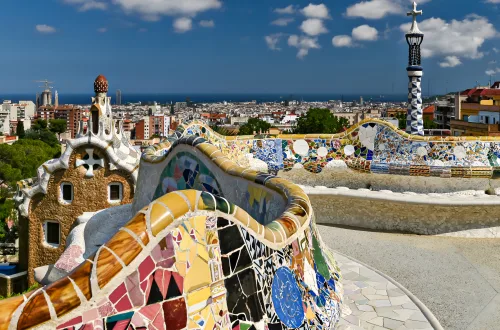
Gaudí’s Magical World: A Tour of Barcelona’s 13 Most Captivating Architectural Creations

Maximize Your Stay: Top Things to See in Barcelona in 2 Days
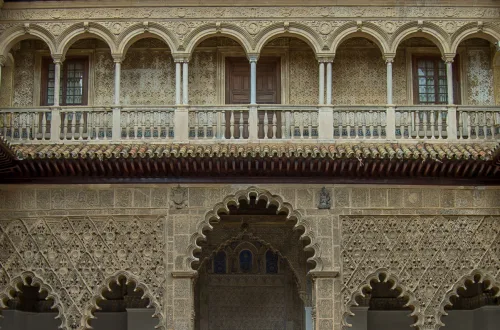
The Allure of Al-Ándalus: Moorish Architecture in Seville
Leave a reply cancel reply.
Your email address will not be published. Required fields are marked *
Save my name, email, and website in this browser for the next time I comment.
The cookie jar
Privacy overview.
Welcome to Madrid
Madrid in the rain
Don't let a little drizzle ruin your visit! Check out all the things you can do in Madrid whatever the weather.
- Read more about Madrid in the rain
- I forgot my password
- At a glance
- Neighbourhoods
- Choose your Madrid
- Art and culture
- Madrid for kids
- Food and drink
- Parks and gardens
- Amusement parks and zoos
- Day trips and itineraries
- Exhibitions
- Theatre and dance
- Special events
- Conferences and trade shows
- Madrid Events Calendar
- AI Assistant
- Where to stay
- Getting around
- Getting here
- Essential information
- Accessibility
- Visitor Services
- Maps and guides
- Learning Spanish
- Other cultures
- Bloggin' Madrid
acueductodesegovia_1400575891.458.jpg
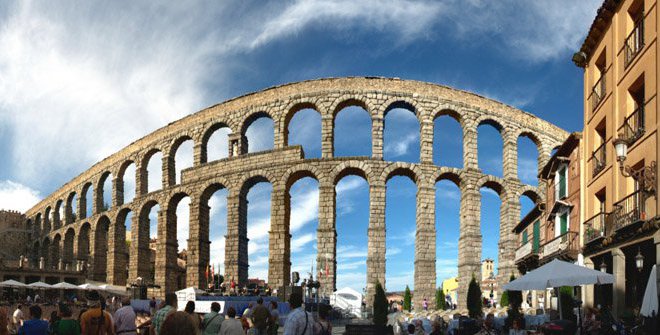
acueductodesegovia_1400575882.52.jpg
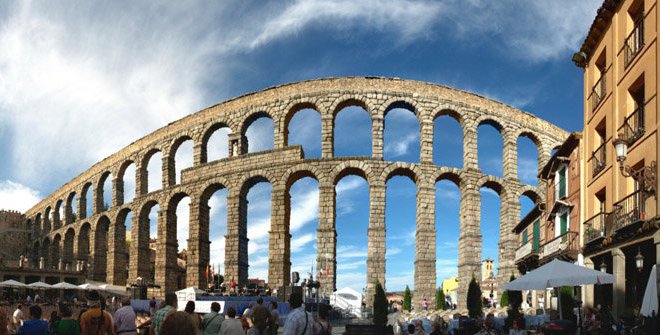
alcazardesegovia_1400575886.431.jpg
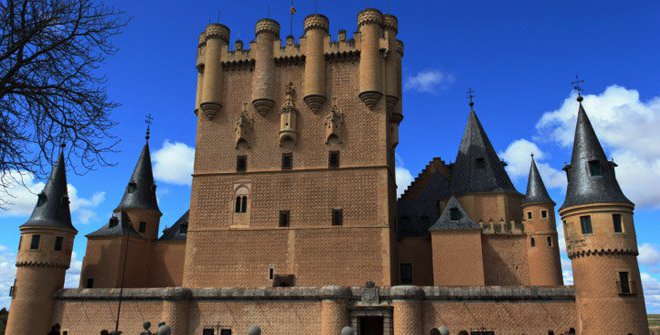
catedraldesegovia_1400575860.352.jpg
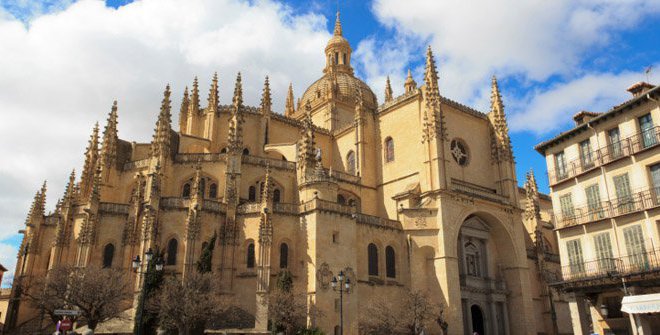
castilloalcazarsegovia_1400575889.506.jpg
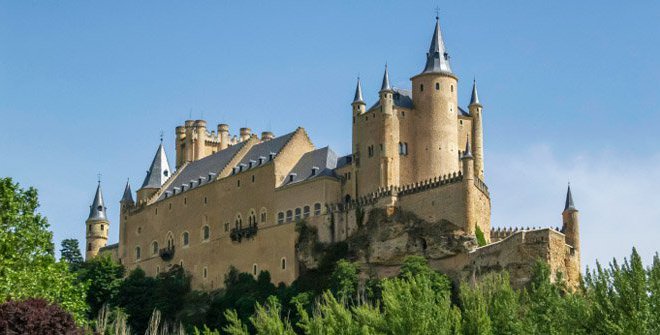
- Sightseeing
- Tradition and food
- Getting there
Close to Madrid , Segovia still retains the spirit of old Spanish cities. These are some of the monuments valued by UNESCO to declare it a World Heritage site in 1985.
The Aqueduct
It is one of the most spectacular legacies of the Roman Empire in Spain. It is made up of 166 arches spanning the more than 17 kilometres of the aqueduct, which transported water from La Acebeda to the Alcázar, defying the laws of gravity, since the only thing that keeps the structure standing is its balance of forces; no kind of mortar was used in its construction. Legend says that Segovia's Aqueduct is the result of a pact between a girl and the devil in which she offered him her soul in exchange for water to reach her house before the crack of dawn.
The Cathedral
The apse of this temple, the construction of which began in 1525, marks the boundaries between the Plaza Mayor and the Judería Vieja (Old Jewish Quarter) . Inside, the 16 th century stained glass windows and the Altarpiece designed by Sabatini are particularly noteworthy.
The Alcázar
The splendid views over the Pinarillo (with the Jewish Cemetery), Zamarramala and the Church of Vera Cruz are reason enough to make your way to this old castle. A deep moat with its drawbridge provides access to this fortress, which became the royal residence in the 13th century, and from whose tower, Alfonso X studied the firmament. To the left, lies the Casa de la Química, built in the period of the Enlightenment, which was Louis Proust's research centre.
Other Places of Interest
- El Azoguejo (diminutive of zoco, the Spanish word for souk). Despite the changes it has undergone over the years, the monumental heritage continues to be the heart of the city. Its streets were the point where the roads converged, and these became the meeting place for traders. Nowadays, it is an excellent starting point to discover the city.
- Canonjías Neighbourhood . This area is where the Casa de la Imprenta and the Casa de la Inquisición were located, but it was also a shelter for artists such as Zuolaga and Maurice Fromkes. It was precisely the American painter who gave the gardens of Calle de Velarde their name, from which the valley of Eresma can be admired.
- Antonio Machado House . At number 5, Calle Desamparados, you can visit the former Casa de Huéspedes, where Antonio Machado lived for 12 years.
- Caballeros Neighbourhood . This area is home to some of the most interesting Romanesque churches in the city: Trinidad, San Nicolás, San Martín and San Sebastián. Inside the Dominican convent, visitors will be able to see the sculpture in the Tower of Hercules, which represents Hercules, founder of the city.
- Old Synagogue . What was once the largest synagogue in Segovia is now the Corpus Christi Convent.
- Segovia City Walls . With a perimeter of more than 3,000 metres, these walls enclose the city and still retain 3 of their 5 original gates. Interestingly, gravestones from the ancient Roman necropolis were used in their construction.
- La Judería . Take a stroll around the charming streets of the city’s old Jewish Quarter, including Judería Vieja, Santa Ana, Corralillo de los huesos…, marvel at the San Andrés Gate, or visit the Judería Education Centre… these are just a few options for what you can do in this area.
- Esteban Vicente Museum of Modern Art . It’s well worth a trip to the centre dedicated to this artist, as well as other museums in the city such as the Museum of Segovia.
Certain sculptures found in the region lead to the belief that Segovia's roots were Celtiberian. The Roman Empire soon conquered these lands, providing them with spectacular buildings such as the Aqueduct.
Historians maintain that, after the Muslim invasion, Segovia was abandoned by its inhabitants. It wasn't until the end of the 11th century that it recovered its energy, led by Alfonso VI and Christians from various parts of the north of the Iberian Peninsula and, even, France.
The Middle Ages enabled Segovia to enjoy great splendour; numerous Romanesque churches were built, its baking industry grew strong and its territory extended beyond the sierra. By the time the main Jewish quarter was founded, the city had become home to the royal court, thanks to Alfonso X The Wise, who designated the Alcázar as his residence. Not in vain, in 1474, Isabel la Católica was crowned queen of Castile in the church of San Miguel.
Later on, its industrial prosperity allowed aristocrats and rich manufacturers, who competed in the palaces they built, to settle there in the 16th and 17th centuries. It was they who provided the city with such wonderful architecture, adorned with Renaissance patios and gardens and Baroque coats of arms. Nevertheless, the 19th century was synonymous with the decline of the city, which was invaded by the French and the Carlists. It later became a refuge to artists and intellectuals such as Zuloaga or Antonio Machado, the poet, who chose to move to Segovia to live and develop his dream of building the University of the People, a university for everyone.
Among the most prominent products that will tempt those who explore the Segovian shops are the copper cauldrons and mirror frames, Segovian-stitch embroideries, garments woven with Pradeña wool, and products made from Maderuelo leather or Ayllón plaited straw, all of which are handcrafted. To really show it off, popular open-air markets have been held for decades, where pulses and vegetables, flowers, clothes and traditional bakery are also available for sale.
For those interested in purchasing some typical products, visit the Diablo Cojuelo shop, specialised in Delicatessen products, the Limón y Menta cake shop with typical cakes from Segovia, or Hermanos María Moreno Cochinillos , a company that has been selling suckling pig for more than 26 years.
The secret of Segovia's rich cuisine lies not in the way the food is made, but in the quality of the local products with which the recipes, inherited from the traditional kitchens of old taverns and from the stoves of the homes of the locals themselves, are made. The closeness of the mountains provides a large variety of mushrooms and fungi, while the orchards that still remain in the valleys of Segovia produce fresh fruit and vegetables.
Segovia is surrounded by two mountain rivers that provide delicious trout for its cuisine. No traveller can end a visit without having tasted the Segovian speciality: the suckling or roast pork, which is at its prime when the skin is so crunchy that it can be carved with the side of a plate. All of that, washed down with local wines, the whites from Nieva or the reds from Valtiendas.
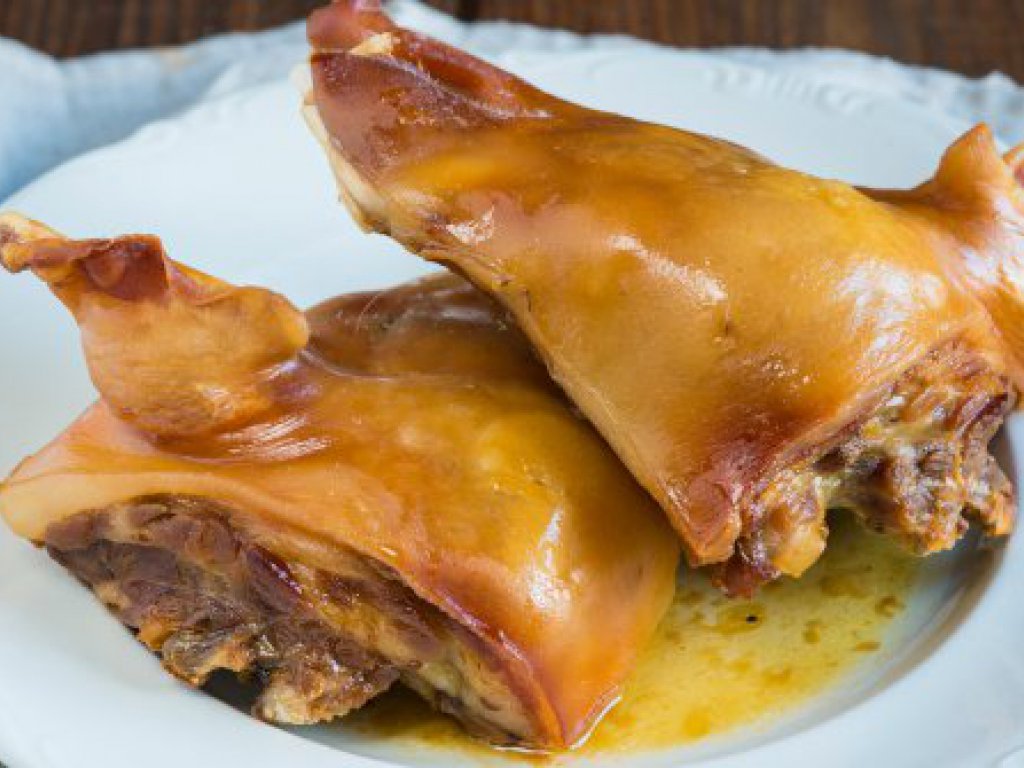
A typical restaurant where you can taste the traditional roast suckling pig is Mesón de Cándido , which offers traditional Castilian cuisine next to the Aqueduct. Also the José María Restaurant by the hand of the chef José María Ruiz Benito, one of the greatest exponents of Segovian cuisine. In the centre of Madrid, you can also sample typical Segovian-style roast suckling pig at the restaurant Horno de Juan . Located in the area of Goya, it has been offering the finest Segovian cuisine for over 50 years.
You can also visit the Juan Bravo restaurant, which is committed to modern cuisine with traditional flavours, associated with the new Castilian cuisine; José María , whose emblematic dish is roast suckling pig; and Casa Silvano-Maracaibo , a large bar specialising in tapas.
To complete this menu, you must try the baked goods such as rosquillas, soplillos, florones, ojuelas and, above all, Segovian punch -sponge, cream and toasted marzipan- made by cloister nuns and pattisiers.
One of the most traditional fiestas in Segovia is held in the Zamarramala neighbourhood where everyone remembers the heroic deeds of the Segovian women who, in the 13th century, were able to entertain the Muslims with their dances and charm while the men took back the Alcázar. So, on the Sunday closest to the 5th of February, the Saint Águeda festivities hand control over to the women. Two lady mayors are appointed and the "Golden Mankiller" prize is awarded. The celebration climaxes with the burning of the pelele (rag doll).
Another highlight is Titirimundi , the puppet and performing arts festival that has been taking to the streets of Segovia every spring since 1985. This festival is a meeting and exchange place for professionals and the public. It is a project that serves to disseminate puppet theatre and other forms of dramatic expression.
- By Car: 70 minutes via the A-6 and the AP-6 toll motorway or via the N-603 (San Rafael-Segovia)
- By Coach: 65 minutes from Príncipe Pío Station.
- By Train: 25 minutes on the AVE from Madrid - Chamartín - Clara Campoamor Station
For further information: Segovia Council
Other Tourist Trains
Cartel_tren_de_cervantes.jpg.
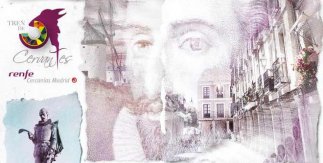
Cervantes Train
A unique way of travelling to and discovering Alcalá de Henares, the birthplace of Miguel de Cervantes. From 20 April to 7 December 2024!
tren_de_la_fresa_2022.jpg
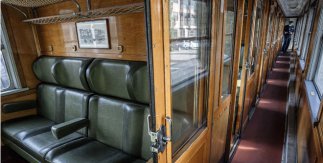
The Strawberry Train
A period train running between the capital and Aranjuez recreates the Madrid area’s first rail line. From 30 March to 10 November 2024.
el_tren_de_arganda.jpg
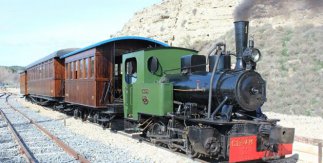
Arganda Train
Get on board this vintage train whose steam locomotive pushes its way past stunning landscapes in southeast Madrid. From 5 October to 29 December 2024
el_tren_de_felipe_ii.jpg
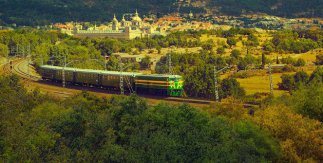
The Philip II Train
Travel from Madrid to San Lorenzo de El Escorial on a vintage train and unveil the secrets of King Philip II’s empire. From 21 September to 14 December 2024.
Segovia Tourist Map (PDF)
Plano_turistico_segovia_pdf.jpg.
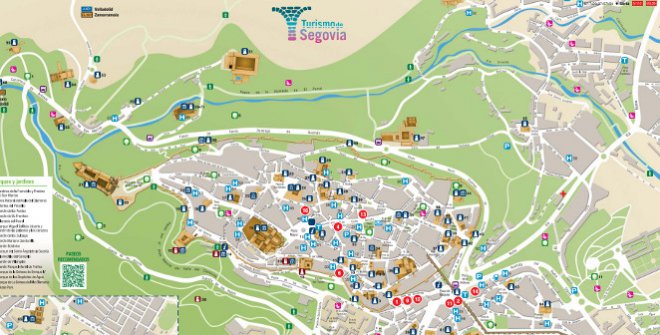
Visit this historic city and discover its numerous tourist attractions, such as the Roman Aqueduct, the Alcázar (fortress) and the Cathedral.
CLOSE TO THE CITY
La_granja_de_san_ildefonso.jpg.
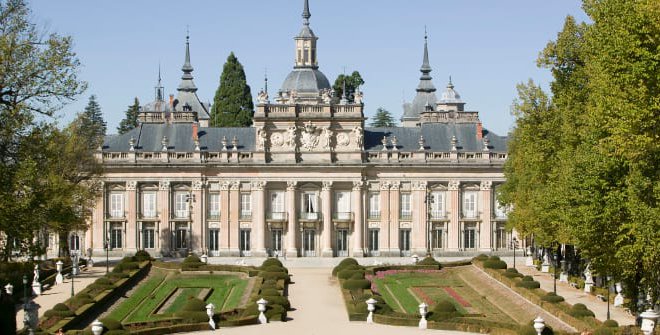
La Granja de San Ildefonso
French formal gardens, monumental fountains, glass factories, beautiful landscapes and delicious judiones beans. There’s much more to La Granja than just its palace.
Titirimundi
Titirimundi.jpg.
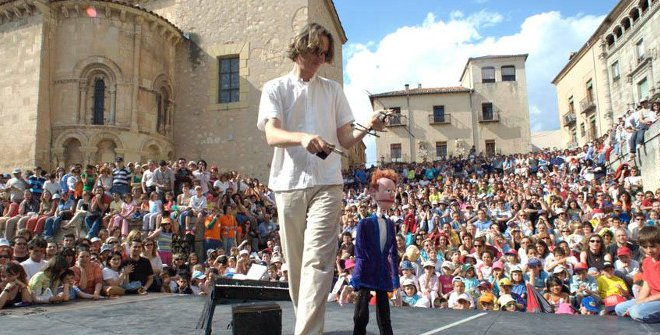
Festival of puppetry and the performing arts that has filled the streets of Segovia every spring since 1985.
OFFICIAL PRODUCTS
Madrid_card_660.jpg.
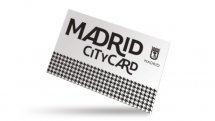
Madrid City Card
The city’s new official sightseeing and tourist travel pass.
farodemoncloalogo.jpg
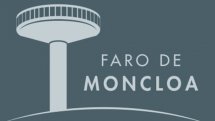
Panoramic views
An observation deck at 92 metres.
tienda_casa_de_la_panaderia_madrid.jpg
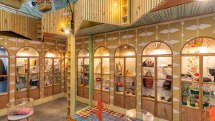
Official Madrid Shop
Our online store (in Spanish) sells artisan souvenirs.
- General Conditions
- Legal Terms and Conditions
- Cookies policy
- Privacy settings
DFP tag: LAYER

18 Top-Rated Tourist Attractions in Segovia
Written by Lisa Alexander Updated Dec 24, 2023
Segovia is a place of romance, a living legacy of the past in an inspiring setting. Perched on a rocky hilltop, this historic walled town boasts stunning views and magnificent monuments.
The ancient aqueduct, fairy-tale castle, awe-inspiring cathedral, exquisite Romanesque churches, and mystical monasteries reveal Segovia's rich cultural heritage.
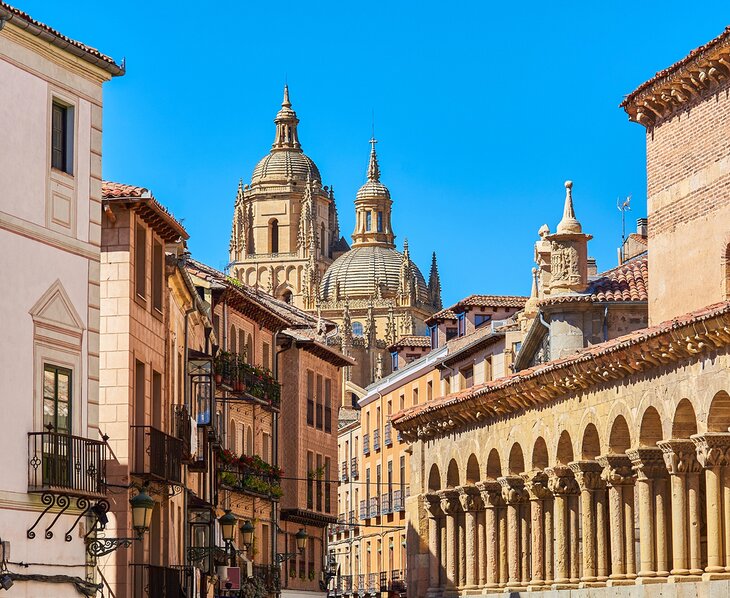
Steeped in complex history, Segovia's heritage begins with the Romans of 80 BCE. The town continued to flourish through the medieval Moorish period, saw the coronation of Queen Isabella "the Catholic" in 1474, and experienced a manufacturing boom in the 16th century. Reminders of all these periods are found throughout the city.
The majority of Segovia's tourist attractions and things to do are found in the Old Town (the historic city center), which is designated as a UNESCO World Heritage site . This atmospheric medieval world is the perfect place to visit if you love tangles of cobblestone streets, ancient alleyways, and charming squares.
While discovering the top attractions, visitors will enjoy wandering the narrow pedestrian lanes to find artisan boutiques, cafés, confectionary shops, and restaurants.
Ancient Roman Aqueduct
Alcázar de segovia, palacio real la granja, catedral de segovia, la judería (jewish quarter), real casa de moneda, iglesia de la vera cruz, monasterio de santa maria del parral, iglesia de san esteban, iglesia de san martín, iglesia de san millán, museo gastronómico de segovia, museo zuloaga, la muralla de segovia (ramparts), iglesia de san justo, iglesia de san clemente, casa de los picos, museo de arte contemporáneo esteban vicente.
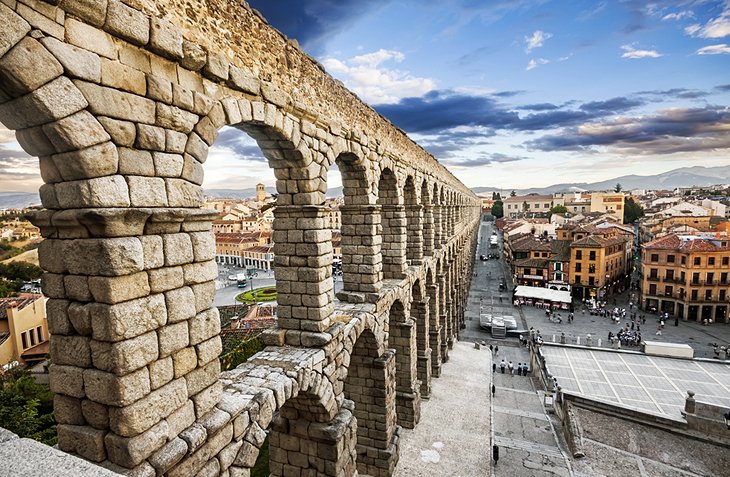
The Roman aqueduct is the symbol of Segovia and forms a magnificent backdrop for the historic city. A UNESCO World Heritage Site , this monumental structure has stood the test of time, enduring two millennia in a remarkably well-preserved condition.
The Segovia aqueduct is one of the two largest existing Roman structures in Spain. Built during the "Flavio" period around 50 CE, the aqueduct channeled water 17 kilometers from the Acebeda River in the Sierra de Fuenfría mountains through a deep valley to the ancient city.
A feat of engineering, the structure was constructed from 20,400 granite blocks without any cement, and the rows of 167 arches have held together in perfect form to this day.
The aqueduct begins near the Granja Palace outside of Segovia and transports water through a canal until it reaches the city.
The best place to view this monument is at the Plaza del Azoguejo , the hub of the Old Town, where the aqueduct reaches its maximum height of 28 meters.
The Plaza del Azoguejo area has many traditional Spanish restaurants (all within easy walking distance of the aqueduct) including the Restaurante Mesón de Cándido , located just beneath the aqueduct; the Restaurante Casa Duque , renowned for its country-style cuisine; and the Restaurante El Cordero , which serves typical specialties of Segovia.
The aqueduct ends at the Alcázar in an underground channel.
Address: Plaza del Azoguejo, Segovia
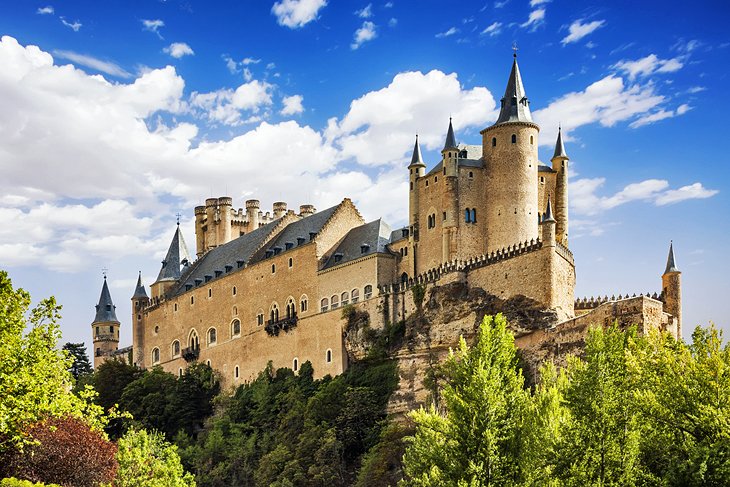
With its turreted towers that seem straight of out Disneyland, this castle makes a fairy-tale impression. The fortress stands majestically above the city on a steep-sided rocky crag. The impenetrable location is testament to the original military purpose of the fortress.
Dating back to the 12th century, the Alcázar served as the royal residence of King Alfonso X in the 13th century. The building was enhanced in elegant Gothic style for Henry IV in the 15th century.
The last architectural renovation was completed in the 16th century by the architect Francisco de Mora. The marriage of Philip II and Anne of Austria was celebrated in the Alcázar's chapel.
The entrance to the castle is at the Torre de Juan II, a 14th-century tower ringed by 10 semicircular turrets. The monument is open to the public for visits (admission fee required) everyday year-round. April through October, the hours are 10am until 8pm; November through March, the hours are 10am until 6pm. Guided tours are available in English, French, and Spanish.
Visitors can tour all the rooms of the Alcázar, which are exquisitely furnished in period style with tapestries, arms, and armor. The Sala del Solio (Throne Room) is noteworthy for its ornate gilded ceiling. The Sala de la Galera has arched windows offering exceptional views of the river valley.
Audio guides (available in English and several other languages) explain each room in detail. The self-guided tour takes about 45 minutes. Guided tours in Spanish are available.
You can also ascend the Tower of John II to admire the views. From this vantage point, the views of the surroundings are amazing, including stunning panoramas of the town, the Sierra de Guadarrama , and the Meseta.
The Alcázar de Segovia is well designed to welcome visitors. Amenities include an information desk, cloak room, gift shop, and a cafeteria with an outdoor terrace that features sweeping views.
Address: Plaza de la Reina Victoria Eugenia, Segovia
Official site: www.alcazardesegovia.com
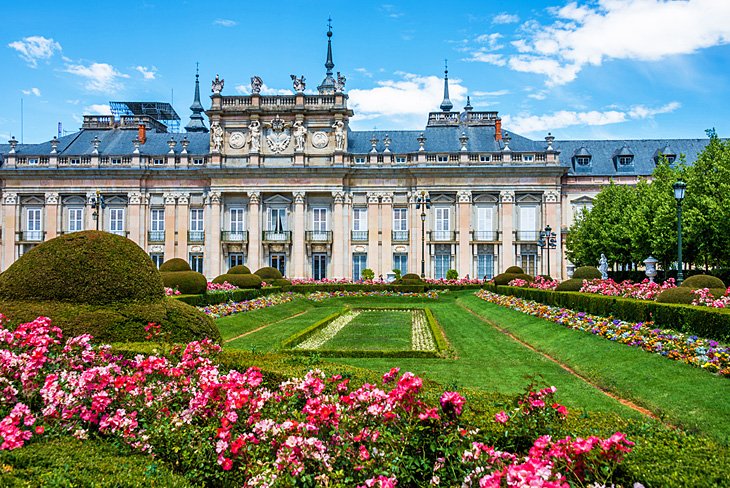
This elegant palace lies 11 kilometers from Segovia in the little town of San Ildefonso, nestled in the Sierra de Guadarrama. The town is a popular weekend retreat for the people of Madrid because of its gorgeous natural setting.
In the early 18th century, Philip V chose San Ildefonso as the site for his palace modeled on Louis XIV's Château de Versailles . Built between 1721 and 1739, the palace beautifully imitates the Baroque style of the famous French palace. Today, the former royal apartments are open to the public.
Visitors can see the Throne Room , the dazzling Room of Mirrors , and other apartments decorated with superb Flemish, French, and Spanish tapestries. The palace has an exquisite church that contains a red marble tomb of Philip V and his wife Isabella Farnese. Surrounding the palace are the Jardines de la Granja , extensive formal French gardens with beautiful fountains, which were modeled after the gardens of the Château de Marly, the leisure residence of Louis XIV.
Other highlights of the Palacio Real la Granja are the Museo de Tapices (Tapestry Museum), which displays exquisite tapestries created in the 16th century, and the Collegiate Church containing tombs of several Spanish monarchs.
Address: Plaza España 15, 40100 San Ildefonso o La Granja, San Ildefonso, Segovia
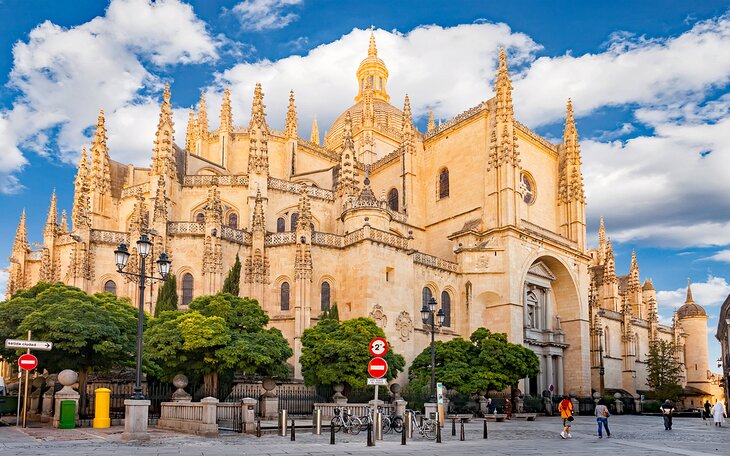
This majestic Late Gothic cathedral stands at the highest point of the Old Town, dominating its surroundings. The location offers commanding views of the entire city and the surrounding Sierra de Guadarrama foothills.
Dating from 1525, this soul-inspiring monument was the last Gothic cathedral built in Spain. The cathedral's intricately articulated façade and soaring towers create an impressive effect. The decorative Puerta del Perdón entrance was the masterpiece of Juan Guas.
Upon entering the enormous vaulted interior, visitors are struck by its Gothic grandeur. Illuminated by vibrant stained-glass windows, the 105-meter-long sanctuary has a sense of serenity and harmony.
Fine sculptures, artworks, and altars decorate the cathedral's 20 chapels, which are closed by grilles. The main altarpiece is beautifully crafted of marble, jasper, and bronze and displays a 14th-century ivory figure of the Virgen de la Paz.
A favorite thing to do for fans of ecclesiastical artifacts, the Museo Catedralicio de Segovia displays liturgical objects, religious paintings, and 17th-century tapestries. Exhibits are presented within 18 chapels of the cathedral. The museum collections contain noteworthy pieces crafted from gold and silver from the 15th to 18th centuries. There are also masterpieces of religious painting and tapestries from the School of Rubens.
The cathedral also has an archive room, the Archivo Capitular , which preserves more than 500 antique songbooks, documents, manuscripts, and books, including the Sinodal de Aguilafuente , the first book printed in Spain. The archive room is open Monday through Friday from 9am until 1pm.
Mass is celebrated at the cathedral Monday through Saturday at 10am, and on Sundays and holidays at 11am and 12:30pm. Tourists may visit the cathedral (admission fee required) Monday through Thursday from 9:30am until 7:30pm, Friday and Saturday from 9:30am until 9:30pm, and Sunday from 12:30pm until 9:30pm. Guided tours (in Spanish) of the cathedral and its tower are available for additional fees.
From May through September, tourists can take advantage of a special event: Visita Nocturna a La Torre (Night Visit to the Tower), which includes a guided tour of the illuminated cathedral and tower. Held on Friday, Saturday, and Sunday evenings at 9:30pm, the guided tour is available in Spanish or English (entry ticket required).
The cathedral stands on the Plaza Mayor in the center of the Old Town. A hub of activity, the square has many sidewalk cafés, and is surrounded by a maze of winding medieval streets that are worth exploring. Outdoor restaurant terraces and café tables spill out onto the square's cobblestone patio space, creating a lively atmosphere.
Address: Plaza Mayor, Segovia
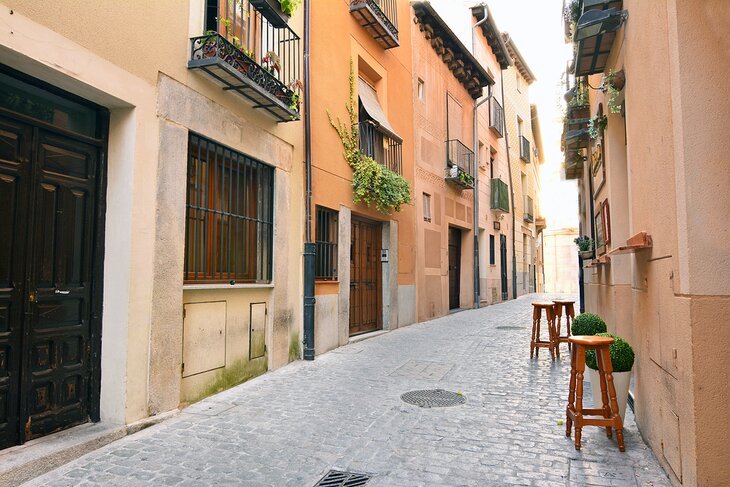
The old Jewish quarter is found in the area of Plaza de la Merced and the parish churches of San Miguel and San Andrés, and extends to the Plaza del Socorro . With its distinctive medieval ambience, the old Jewish quarter of Segovia offers hints of the Sephardic past. Street names like Judería Vieja and Judería Nueva offer the first clues.
The Convent of Corpus Christi also reveals its former life as a synagogue, built in the 13th century, and you can visit to see remnants of the synagogue's original décor, such as columns decorated with pineapples and scrolls. This is the best-preserved of the five synagogues that once existed in Segovia.
The quarter was once enclosed by seven gates including Puerta de San Andrés (Plaza del Socorro), a top sightseeing destination which now presents educational exhibits about local history.
The Antigua Carnicería Judía (Ancient Jewish Butcher) building now houses the Museo de Segovia (11 Calle Socorro), a museum of fine arts, ethnography, and archaeology. The museum is open Tuesday through Saturday from 10am until 2pm and 4pm until 7pm October through June (5pm until 8pm July through September), and on Sundays from 10am until 2pm; it's closed on Mondays, Sunday afternoons, and holidays.
At 12 Calle Judería Vieja, tourists will find the Centro Didáctico de la Judería, where exhibits and videos in English detail the history of Jews in Segovia and elsewhere in Spain. This museum is open every day of the week, but is closed in the afternoon on Monday, Tuesday, and Sunday.
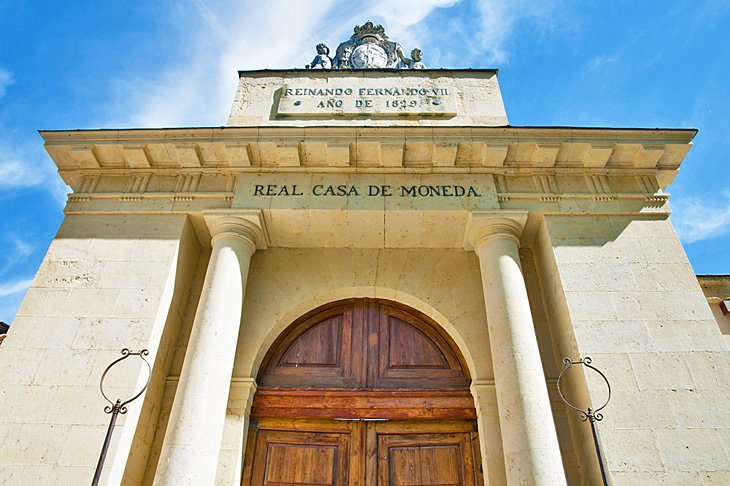
Beside the Eresma River near the Alcázar, the Real Casa de Moneda is Segovia's Royal Mint built in the 16th-century, which makes it one of the oldest examples of a commercial building in Spain. The Royal Mint was founded by Philip II and designed by Juan de Herrera.
The building operated as a mint between 1586 and 1869 and now houses a museum about the history of coin production in Spain. The original hydraulic system of the building is still intact, with a dam in the Eresma river.
The Real Casa de Moneda is open on Tuesday from 10am until 2:30pm, Wednesday through Saturday from 10am until 6pm, and Sunday from 10am until 3pm; closed on Monday.
Address: Calle de la Moneda, Segovia
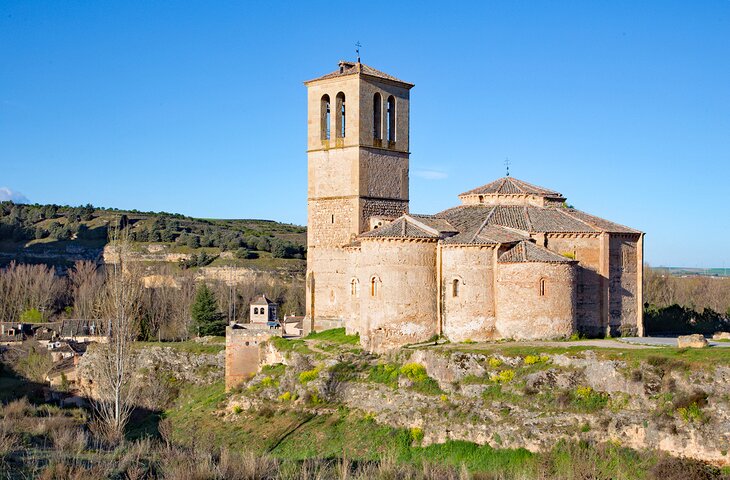
Listed as a National Monument , the Iglesia de la Vera Cruz is a splendid Romanesque church on a lonely road outside the historic town. Founded by the Knights Templar in the 13th century, it was inspired by the Church of the Holy Sepulchre in Jerusalem, where the knights originated. Vera Cruz translates to "True Cross."
The church has a simple, austere interior with three semicircular chapels and Mudéjar-style vaulting. Visitors feel a sense of mysticism in the somber sanctuary. The monument is open to the public from 10am until 1:30pm and 4pm until 6pm (until 7pm in summer) Tuesday through Sunday, and is closed on Mondays.
Also outside the walled Old Town is another attraction, about a 20-minute walk or short drive from the Church of Vera Cruz. Tucked away on the quiet Calle Marqués del Arco, the Convento de San José de las Carmelitas Descalzas was founded in 1586 by Saint John of the Cross. The tomb of this mystic poet who inspired the order is here.
Visitors approach the convent by a steep stone staircase, reinforcing the impression of ascending to a higher spiritual place. The convent is open to the public for visits; check with the Tourist Office about the hours.
Address: Carretera de Zamarramala, Segovia
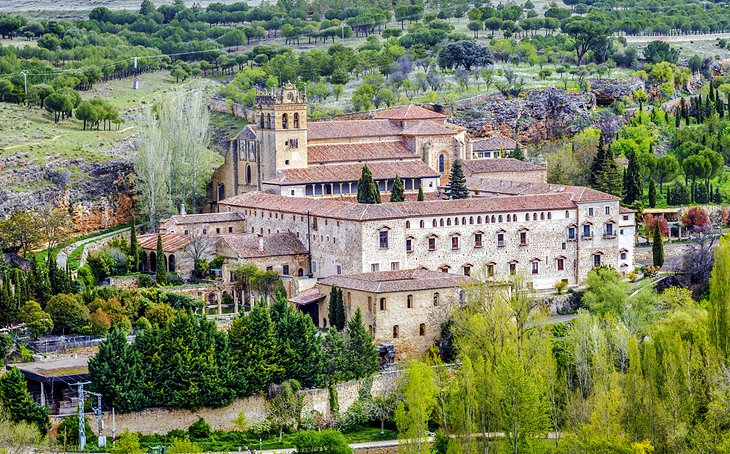
Nestled in the picturesque rolling hills outside of Segovia's historic center, this 15th-century monastery is a peaceful retreat in nature. Founded by Henry IV of Spain, the monastery combines Gothic and Renaissance architectural styles.
The main chapel of the church is Gothic, while the tower of the church is crowned with Renaissance ornamentation. Around the altarpiece are elaborate alabaster monuments to the Marquises of Villena, who were patrons of the monastery.
One of the highlights of the church is the Gothic doorway leading to the ante-sacristy. The monastery has four cloisters: the main cloister, La Portería, La Hospedería, and La Enfermería.
Listed as a National Monument , the monastery is open to the public for visits (donations suggested) from 11am until 5pm Wednesday through Sunday. It's closed on Mondays and Tuesdays. Mass is celebrated with Gregorian chants on Sundays at 12pm.
Address: 2 Calle Parral, Segovia
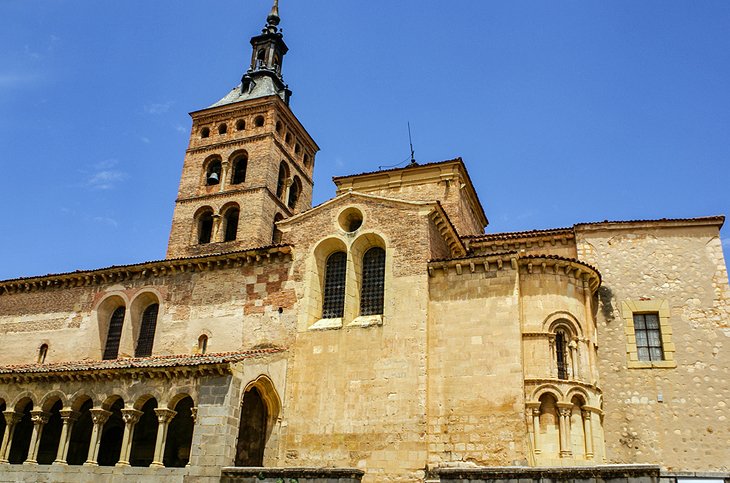
Constructed in the 12th and 13th centuries, the Iglesia de San Esteban is the most renowned of Segovia's Romanesque churches. In the Old Town north of the Plaza Mayor, the church is found in the slightly sloping Plaza de San Esteban .
The building is dominated by its tall tower, which consists of six arched segments relieved and topped by a steeple with a weathercock. Like most of Segovia's Romanesque churches, San Esteban has a loggia where meetings of the guilds were held.
Address: Plaza San Esteban, Segovia
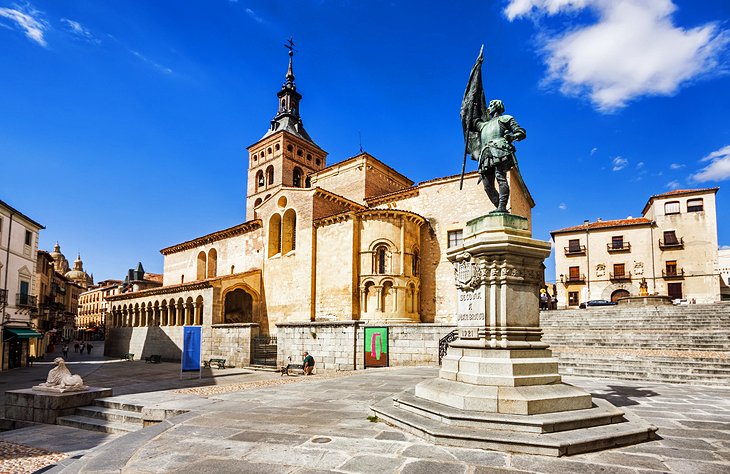
The splendid 12th-century Iglesia de San Martín exemplifies Castilian Romanesque architecture. The Gothic Capilla de Herrera contains tombs of the Herrera family, and the Capilla Mayor has a noteworthy recumbent figure of Christ by Gregorio Fernández.
Other remarkable artworks are the marble plaque depicting Saint Martin, the richly carved capitals featuring floral motifs and Biblical scenes, and the triptych by the Flemish painter Adriaen Isenbrandt.
The church faces the picturesque little Plazuela de San Martín , with its fountain decorated by two mermaids. On the steps up to the square is a house with a four-arched gallery that was the birthplace of Juan Bravo, one of the leaders of the rising of the Comuneros, while next to it is the impressive 16th-century Torreón de los Lozoya .
Address: Plazuela de San Martín, Segovia
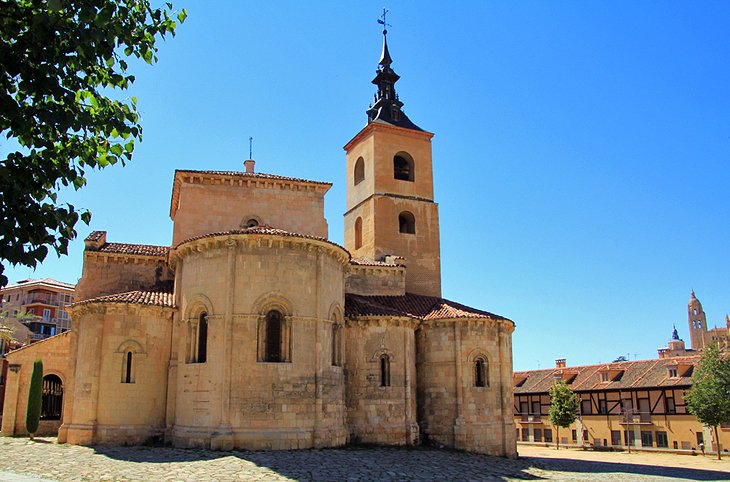
The Iglesia de San Millán lies outside the walled historic center of Segovia, in the old Moorish quarter where Mozarab artisans once worked.
The church is a typical 12th-century Romanesque church with three naves and three apses, yet the architecture also reveals some Islamic influence, including Caliphate-style vaulting and decorations.
Modeled after the Cathedral of Jaca, the church has a tower from a previous Moorish building. The interior features exquisite Mudéjar art works, horseshoe arches, and an interesting 14th-century Gothic crucifix.
Address: Avenida Fernández Ladreda, Segovia
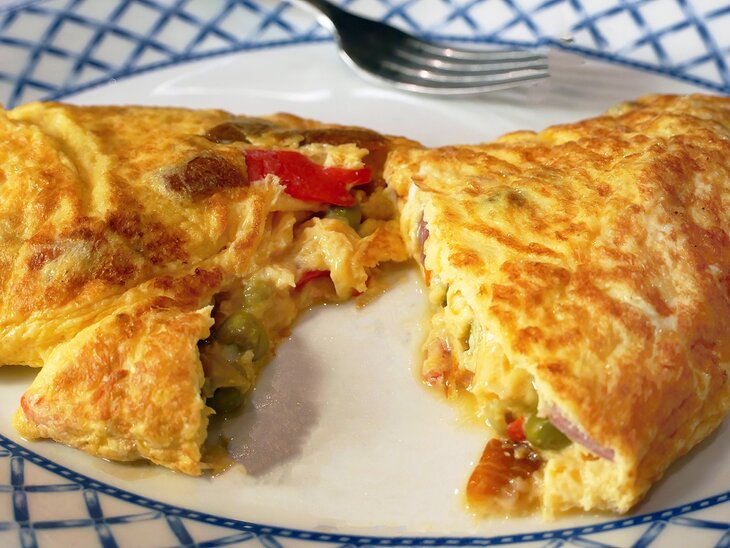
The Gastronomic Museum of Segovia introduces the traditional food products of the region, with exhibits, utensils, and audiovisuals. Located in an old house, part of the museum includes remains of its Roman origins.
For gourmands, this museum is one of the best places to visit for an overview of local cheeses and other regional specialties. The exhibits describe gastronomic delicacies, such as dishes typically offered in Segovia restaurants. There's even the chance to sample the specialties.
Address: Calle Daoiz 9, Segovia
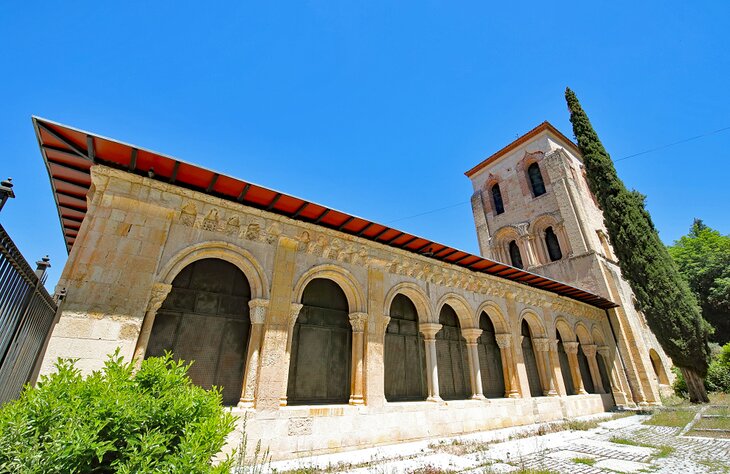
In the Old Town , from the Plaza del Azoguejo, steps beside the aqueduct ascend to the upper town.
From the top, a street to the right leads to the Plaza Colmenares, and in this square is the Iglesia de San Juan de los Caballeros . Constructed between the 11th and 13th centuries, this Romanesque church was once the burial place of the leading families of Segovia.
Daniel Zuloaga bought the Church of San Juan de los Caballeros in 1905 and used the interior space as an art studio. The building now houses the Museo Zuloaga , which displays paintings by Ignacio Zuloaga and ceramics and other art works by Daniel Zuloaga.
Address: Plaza de Colmenares, Segovia
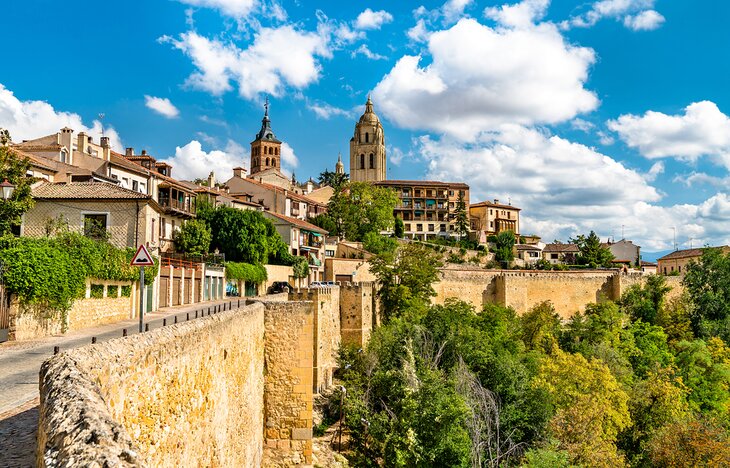
A typical medieval walled town, Segovia is surrounded by formidable ramparts dating back to the 11th century. A substantial portion of the ancient limestone walls has been preserved, starting at the Alcázar fortress.
The ramparts feature characteristic crenellations, blind arches, towers, and entrance gates with horseshoe arches. Three of the old entrance gates remain: San Andrés gate, San Cebrián Gate, and Santiago Gate.
For tourists, walking along the ramparts is one of the best ways to view the city's monuments. Inside the former guards' headquarters, tourists can see the walls that defended the upper areas of the city.
Address: Punto de Información Turística La Muralla, 6 Plaza del Socorro, Segovia
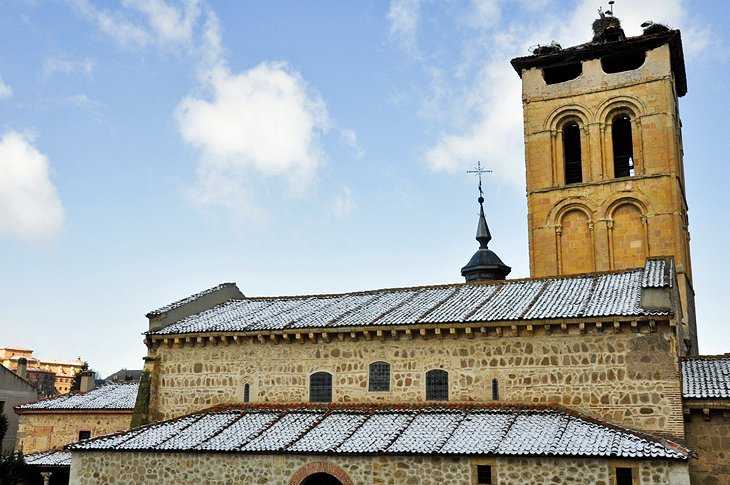
Near the ancient Roman aqueduct, the Church of San Justo is a gem of Romanesque architecture with a prominent tower.
The church was built in the 13th century and was an important stop on the Way of Saint James medieval pilgrimage trail to Santiago de Compostela in northern Spain .
Although the church is small, it is a treasure trove of art works. Particularly noteworthy are the vibrant Romanesque frescoes in the apse, with an impressive Pantocrátor and scenes from the Passion of Christ and the lives of the Saints.
Address: Calle Pedro de Fuentidueña, Segovia
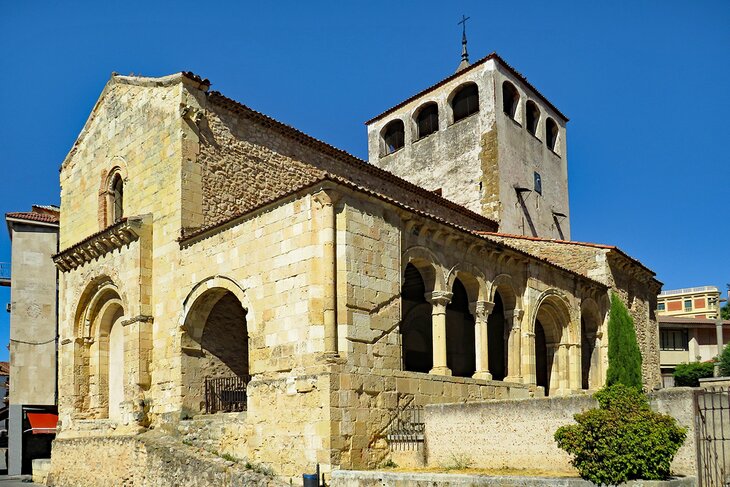
Outside of Segovia's ancient walls, from the Plaza del Azoguejo, the Avenida de Fernández Ladreda runs southwest to the Iglesia de San Clemente. This exquisite 13th-century Romanesque church has an arcaded portico on the exterior.
The interior features an interesting apse featuring blind arches. Not to be missed are the 13th-century frescoes on the righthand side of the Capilla Mayor.
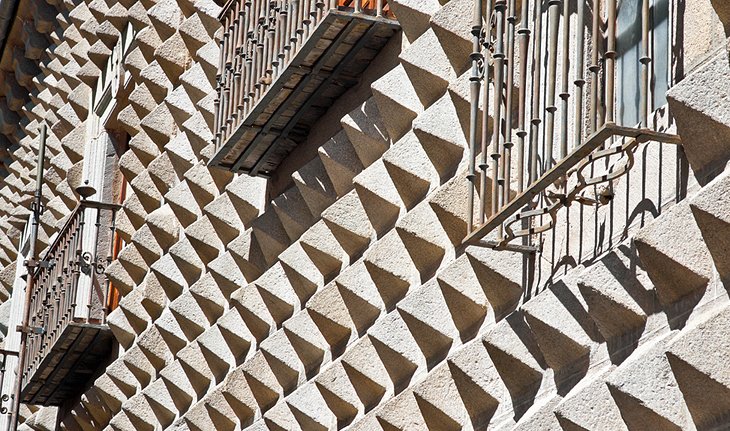
This 15th-century aristocratic mansion is worth a detour to admire its striking façade resembling a coat of armor, with a relief of pyramid-shaped granite blocks. Notice the coats of arms above the balconies, reflecting the stature of the De la Hoz family who owned the house.
Charming decorative tiles featuring pictures of Segovia buildings are found at the entrance and in the courtyard. The Casa de los Picos now houses the Segovia Art School and an exhibition hall that presents temporary exhibitions throughout the year.
To arrive here, take the Calle Cervantes or the flight of steps beside the aqueduct and turn left at the top.
Address: Calle Juan Bravo 33, Segovia
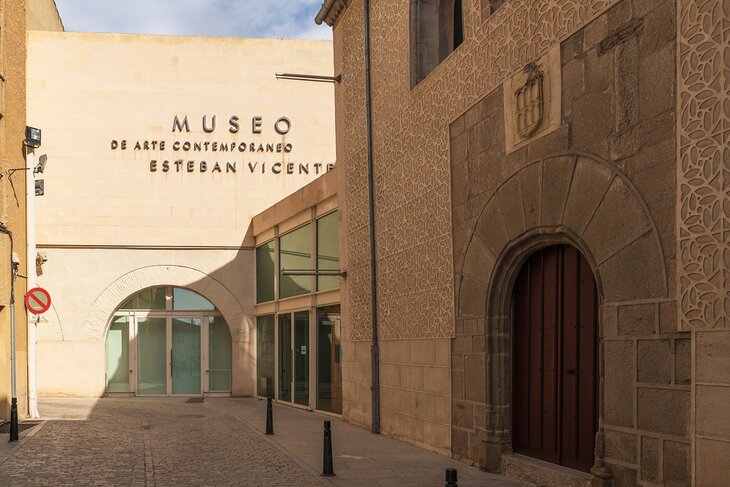
Fans of abstract and modern art will want to stop into the converted 15th-century palace of Henry IV, now a gallery of the works of 20th-century Spanish painter Esteban Vicente.
The modern exhibit spaces are dedicated to the collection of 153 works by Vincente, which include oil paintings, collages, drawings, small sculptures, and works in other media.
The greatest emphasis is on those done later in his career, when he lived and worked in the United States, but the entire evolution of his work in various media is covered.
Address: Plazuela de las Bellas Artes, Segovia
Official site: http://museoestebanvicente.es/en/
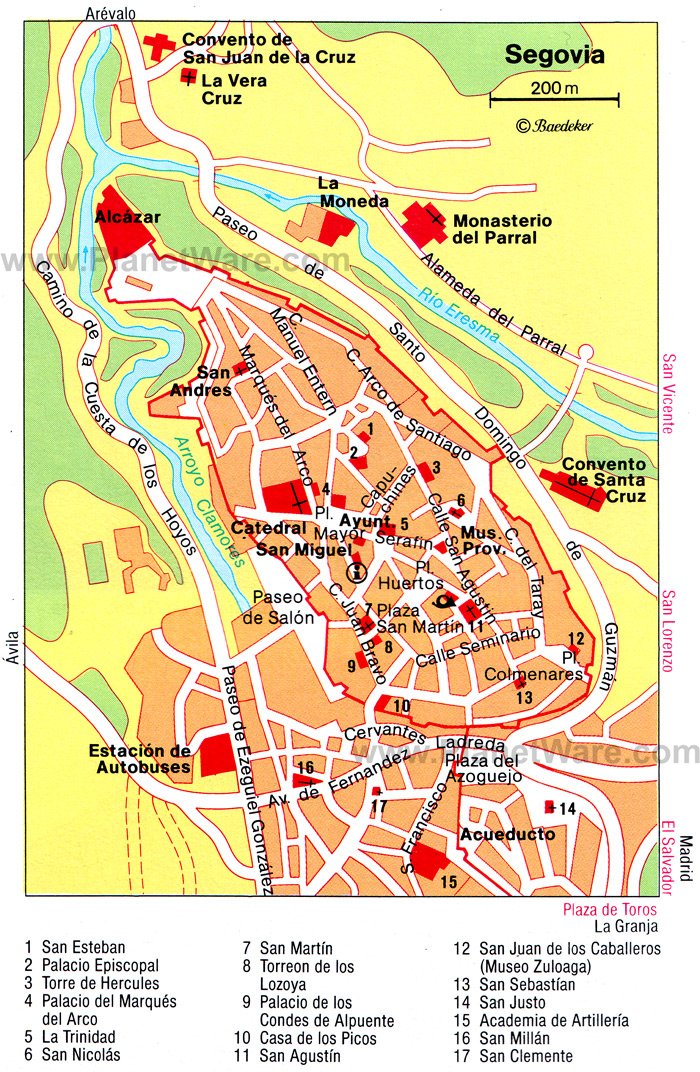
More on Spain
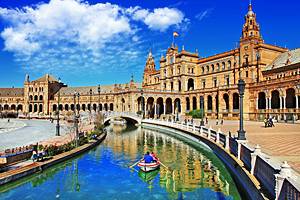

IMAGES
VIDEO